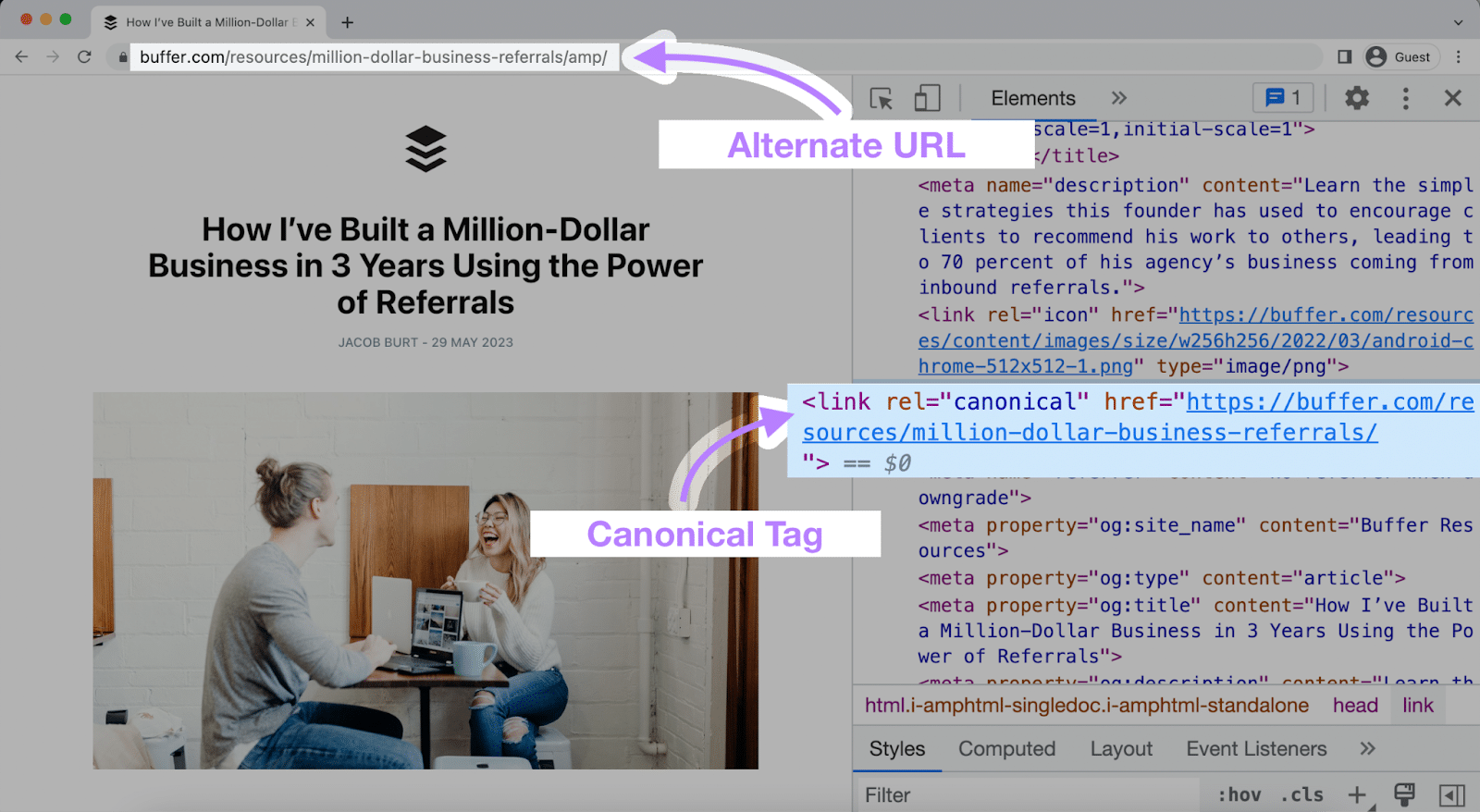What Is a Canonical URL?
A canonical URL is the model of a webpage chosen by search engines like google and yahoo like Google as the primary model when there are duplicates. And is prioritized to keep away from exhibiting repetitive content material that doesn’t present distinctive worth in search outcomes.
Contemplate these two URLs:
- Canonical URL: https://instance.com/weblog/
- Non-canonical (alternate) URL: https://instance.com/weblog/?web page=1
On this instance, Google will seemingly select the canonical URL for indexing and rating.
The canonical web page will also be known as the “principal,” “major,” or “consultant” model.
Notice
Google doesn’t at all times make the choice you need. However you’ll be able to affect canonicalization through the use of canonical tags. And some different strategies we’ll go over later.
What Is a Canonical Tag?
A canonical tag (also called the rel=”canonical” tag) is a snippet of HTML code that lets you outline the first model in a set of duplicate or near-duplicate pages in your web site.
In search engine optimization, canonical tags recommend to Google which model of the web page it ought to index, consolidate hyperlink fairness (rating power) to, and present in search outcomes.
Canonical tags are discovered within the <head> part of a webpage’s HTML supply code and appear like this:
<hyperlink rel="canonical" href="https://instance.com/preferred-url-here/" />
Right here’s how that works in observe on one of many alternate pages:
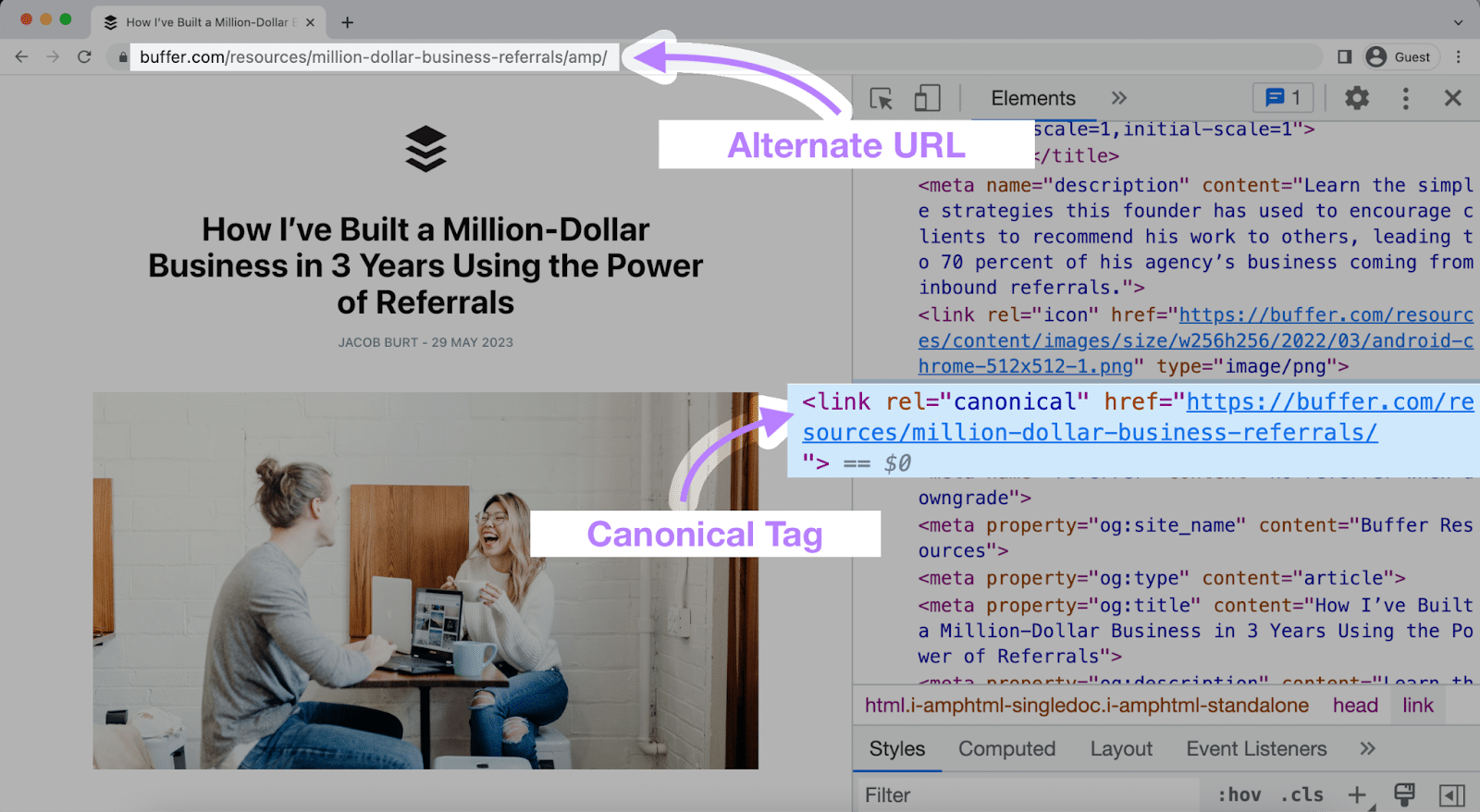
Usually, canonical tags level from an alternate web page to the popular web page.
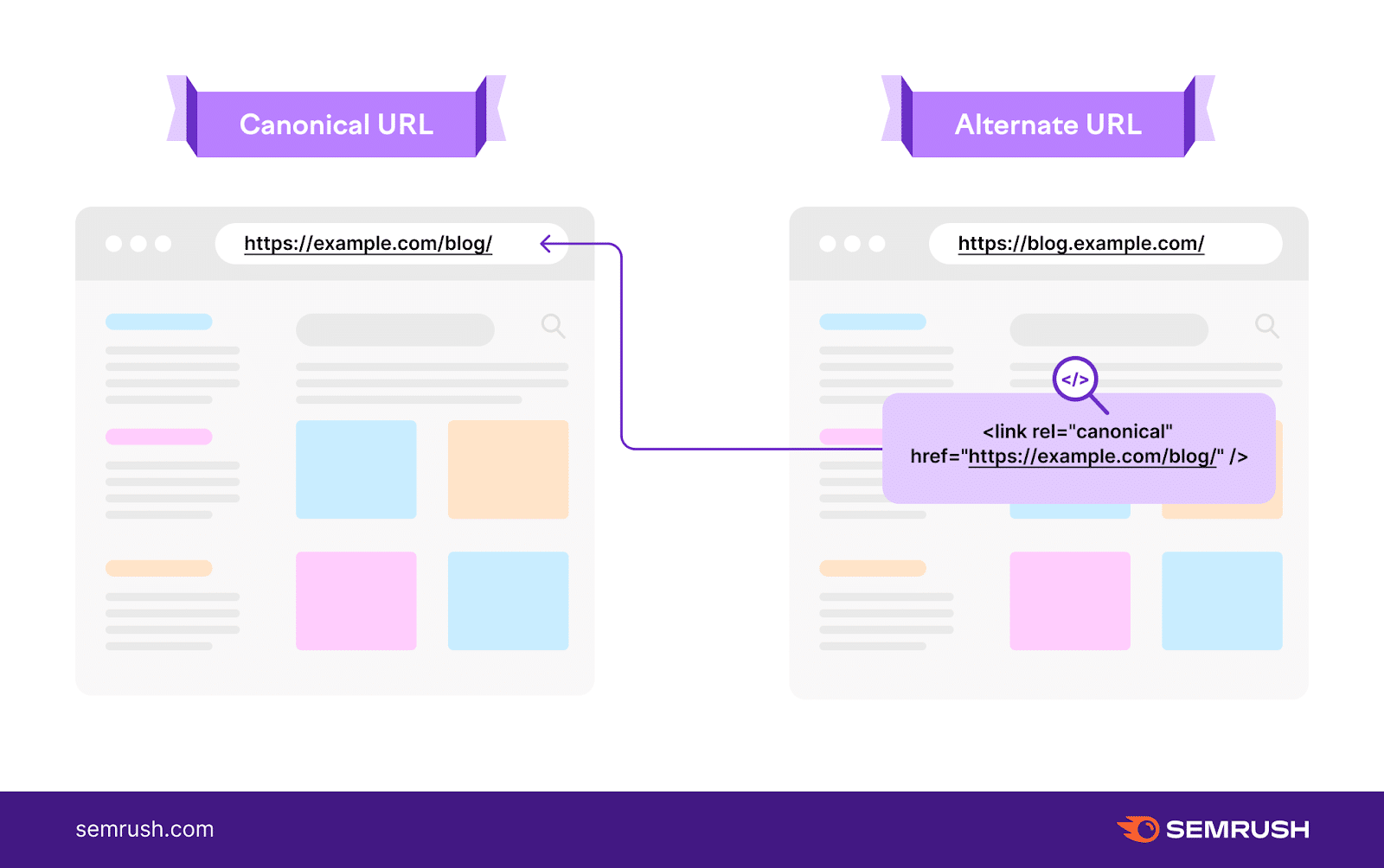
Nevertheless it’s additionally a good suggestion to make use of self-referencing canonicals.
In different phrases, every canonical web page ought to have a canonical tag that factors to its personal URL.
Like this:
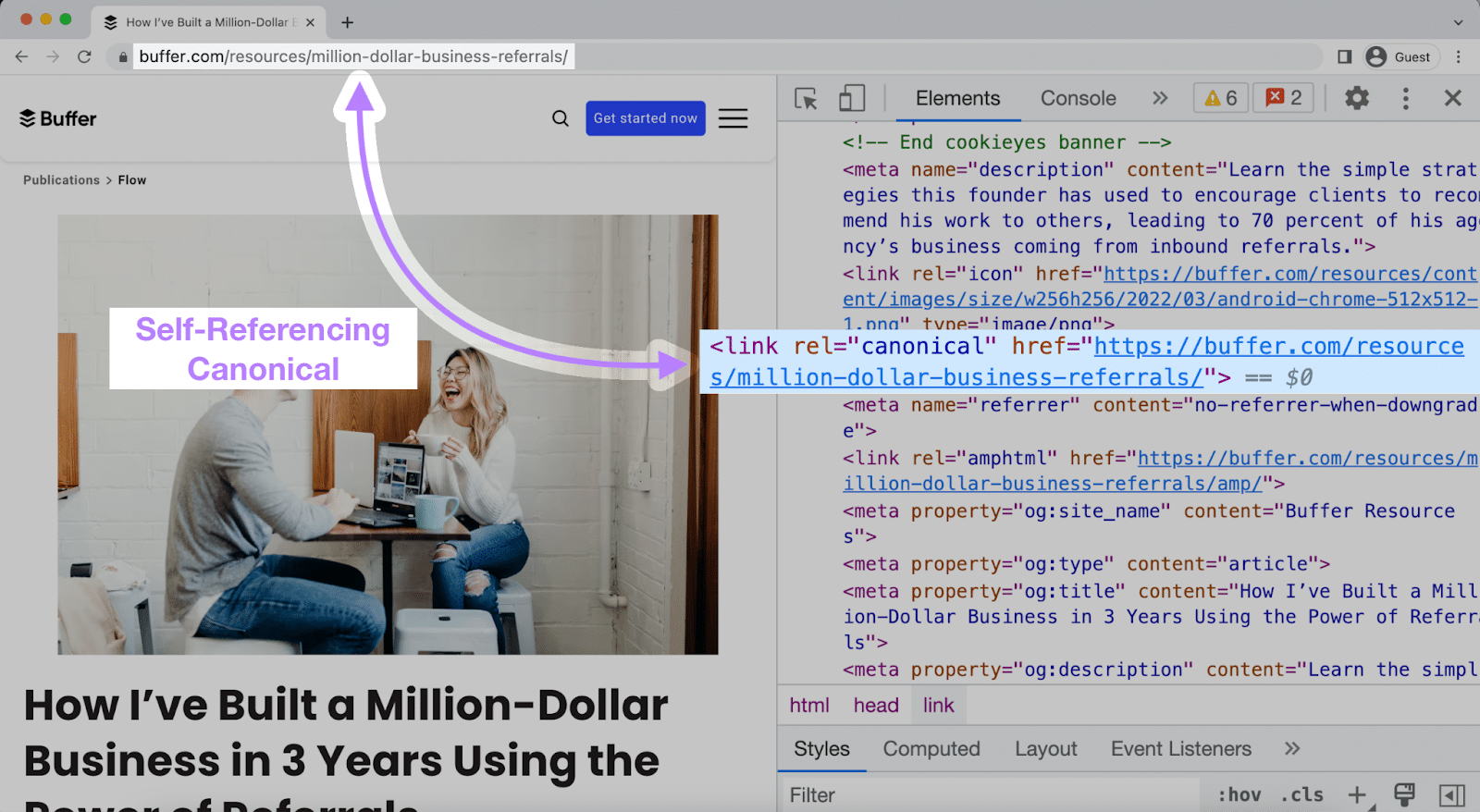
Google’s John Mueller confirmed the significance of self-referencing canonicals in a Google Search Central hangout.
Professional tip
Use Semrush’s Website Audit to see in case your web site has duplicate content material points. And if canonical URLs are applied appropriately.
Why Use Canonical Tags?
Canonical tags are a invaluable deduplication software. They will resolve points with duplicate content material (or near-identical pages) it’s good to hold.
For instance:
- American English and British English variations of the identical web page
- Parameterized URLs (e.g., itemizing pages with filters or sorting choices utilized)
Why keep away from duplicate content material?
As a result of it could trigger key phrase cannibalization. This happens when a number of pages on a web site compete for a similar key phrases. And hurt one another’s rankings within the course of.
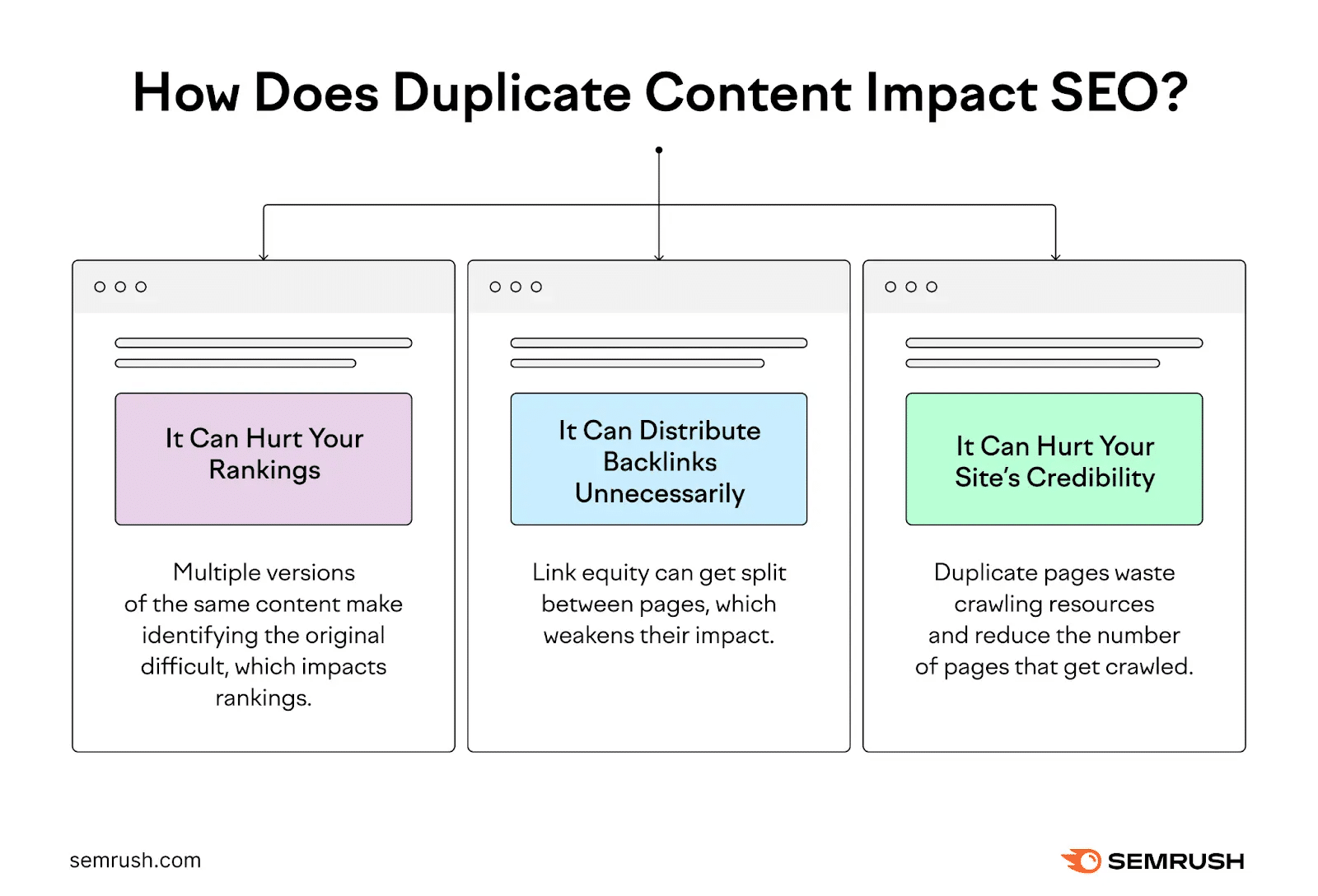
Utilizing canonical tags appropriately helps Google perceive your web site’s construction. And establish the most effective model of a duplicated web page.
This helps make sure the model you need is the one proven in search outcomes (and the one searchers entry). Which may result in increased click-through and conversion charges.
Plus, Google consolidates the rating energy of alternate pages to canonical URLs.
Let’s say you could have backlinks (hyperlinks from exterior domains) pointing to varied duplicate pages. Should you’ve used canonical tags, Google treats all of them as hyperlinks to that essential URL. To positively influence rankings.

Notice
Google not recommends utilizing canonical tags for syndicated content material. As a substitute, syndication companions are suggested to dam indexing with the correct meta tags.
Easy methods to Implement Canonical Tags
To implement canonical tags in your HTML, you’ll be able to add the rel=”canonical” tag to the <head> part of the web page.
As a reminder, that appears one thing like this:
<hyperlink rel="canonical" href="https://instance.com/preferred-url-here/" />
However the actual method to implement them is a bit completely different relying in your platform. Let’s go over 5 of the most typical:
Magento 1
Should you’re working a Magento 1 retailer, comply with these steps to specify canonical URLs for product and class pages.
Product Web page Canonicals
Log in to your admin panel, then head to “System” > “Configuration.”
Click on “Catalog” and open the “Search Engine Optimizations” part.
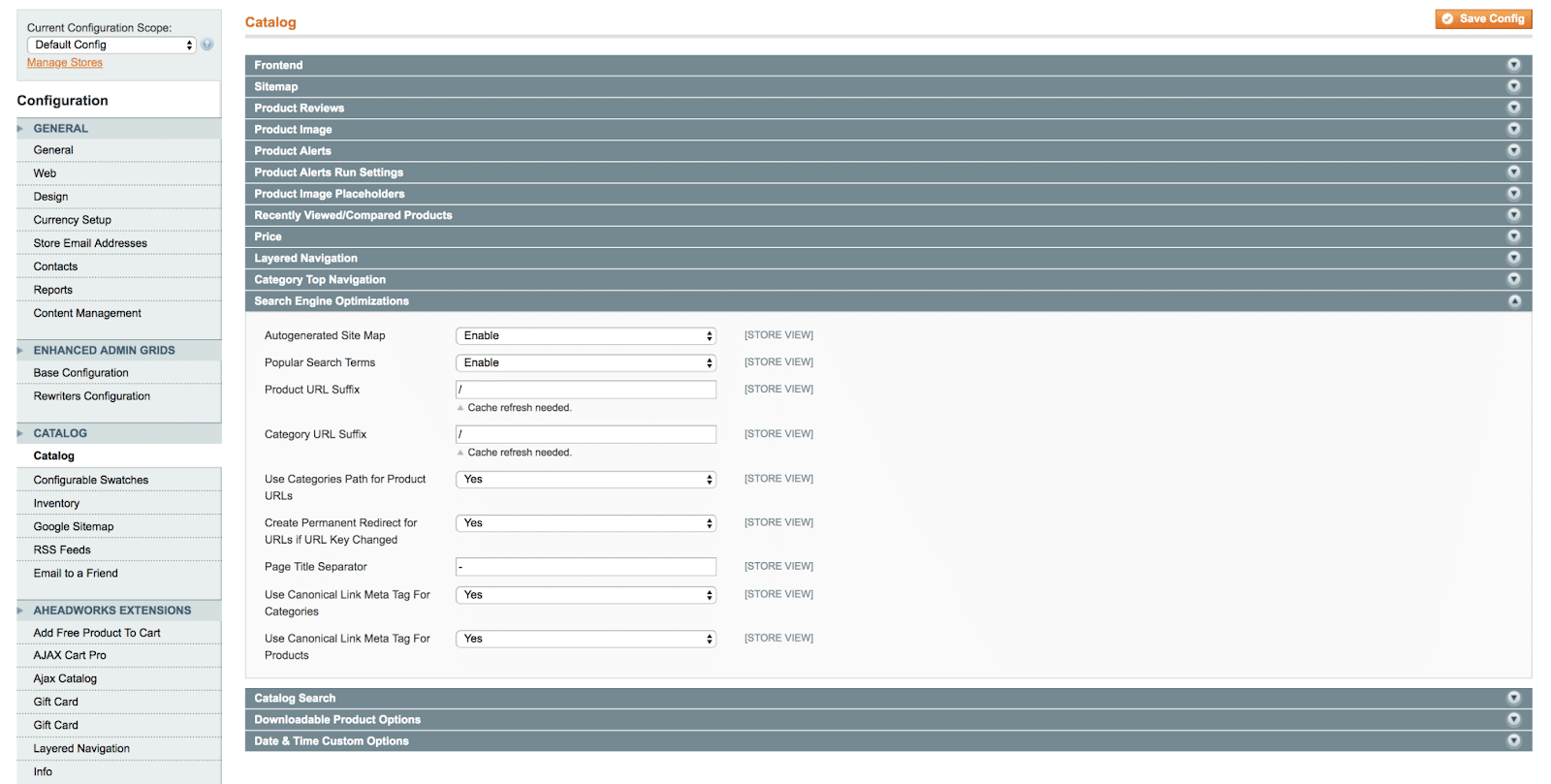
If it isn’t already, set the “Use Canonical Hyperlink Meta Tag For Merchandise” discipline to “Sure.”

Class Canonicals
Head again to the “Search Engine Optimizations” part on the “Catalog” web page.
Discover the “Use Canonical Hyperlink Meta Tag For Classes” possibility and ensure it’s set to “No.”

Now, you’ll be able to manually specify the canonical URL for classes.
Head to the edit web page of any class you wish to canonicalize and discover the “Customized Design” tab.
Within the “Customized Format Replace” field, add the next code (ensuring to swap in your canonical URL).
<reference title="head">
<motion technique="addLinkRel">
<rel>canonical</rel>
<href>https://instance.com/preferred-url-here/</href>
</motion>
</reference>

Magento 2
Should you’re working a Magento 2 retailer, comply with these steps to specify canonical URLs throughout your web site.
Log in to your admin panel, then go to “Shops” > “Settings” > “Configuration.”
Subsequent, open “Catalog” > “Catalog” and go to the “Search Engine Optimization” part.
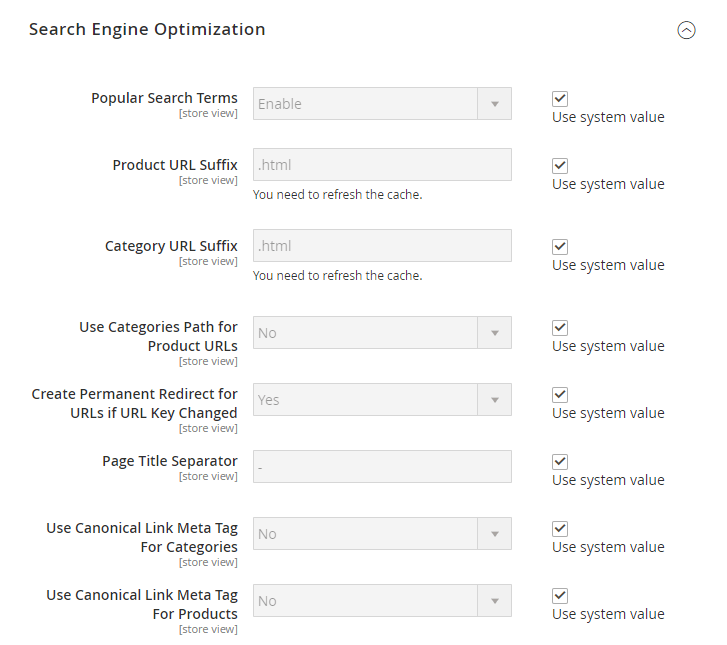
Picture Supply: Amasty
Set “Use Canonical Meta Tags For Classes” to “Sure.” So Magento will robotically add canonical tags to alternate class pages.
The default config path is “catalog/search engine marketing/category_canonical_tag.”
Additionally set “Use Canonical Meta Tags For Merchandise” to “Sure.” So Magento will robotically add canonical tags to alternate product pages.
The default config path is “catalog/search engine marketing/product_canonical_tag.”
Shopify
Shopify robotically handles canonical tags for product pages, collections, and weblog posts.
This built-in system works nicely for many setups. Like if:
- Your merchandise have variants (like completely different colours or sizes)
- You utilize pagination or filtering on assortment pages
- You may have commonplace weblog posts
In case your web site is extra advanced and requires some further work to implement canonical tags, you’ll be able to add them manually.
Go to your Shopify admin, choose “Themes” from the menu to the left, and click on “Actions” > “Edit Code.”
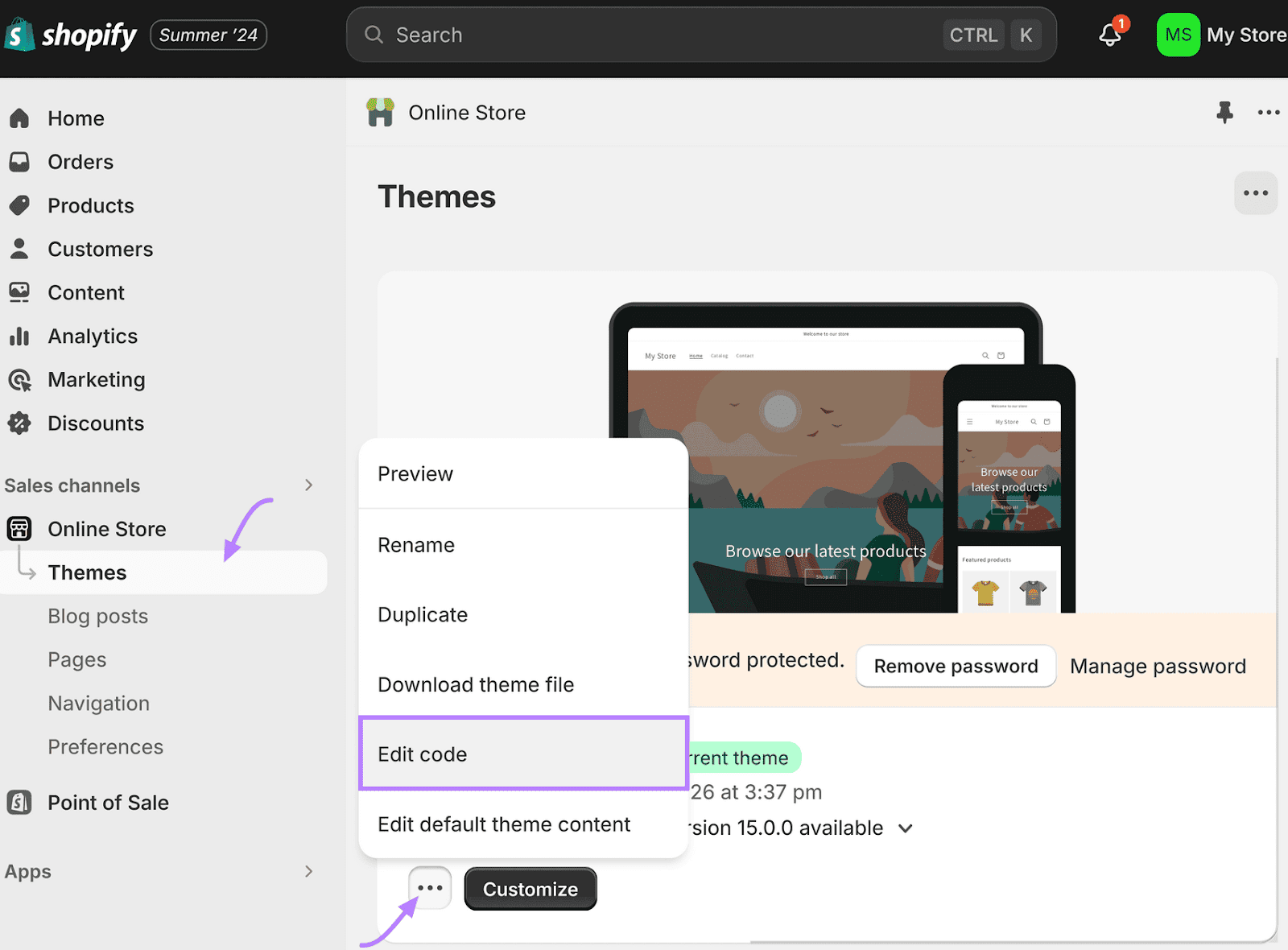
Within the left sidebar, click on on the file you wish to edit. Should you’re implementing one thing that may apply throughout your web site, you’d select “theme.liquid.”
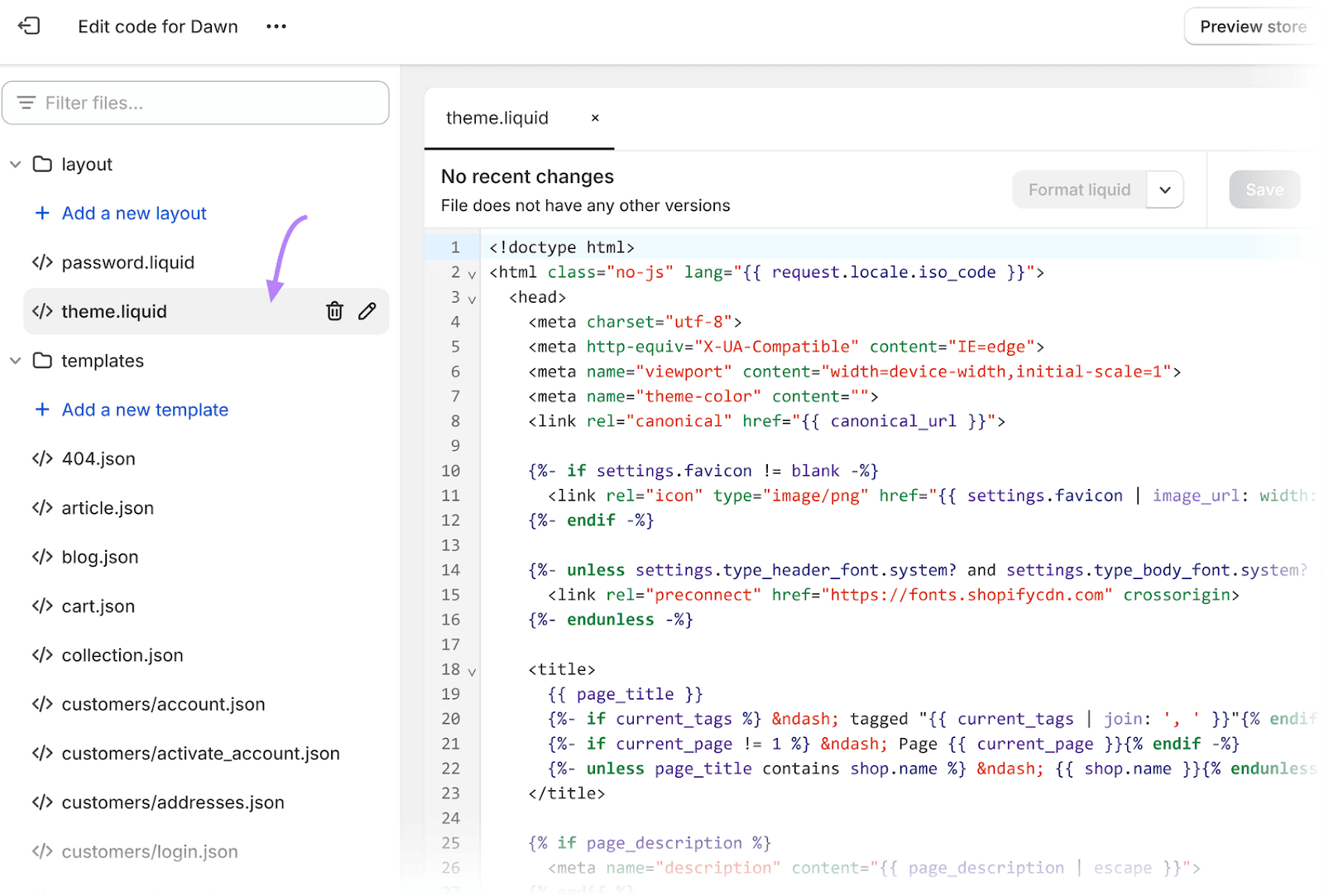
From right here, you’ll must edit the code utilizing the suitable metafield (a discipline you should utilize for personalization). This requires a good quantity of technical know-how, so you might wish to work with a developer.
There are additionally a number of Shopify apps accessible so as to add canonical tags.
Canonical Tag URL Wizard is a well-liked alternative. As a result of it allows you to handle canonical tags with out diving into code.
Notice
For many Shopify shops, the built-in canonicalization is sufficient. Solely customise if in case you have a selected want. When doubtful, select an skilled from Shopify’s companion listing for session.
WordPress
You may set canonical URLs in your WordPress web site through the use of a WordPress search engine optimization plugin.
We’ll take a look at how to do that with two of the preferred plugins: Yoast search engine optimization and Rank Math search engine optimization.
Yoast search engine optimization Plugin
Should you’re utilizing the Yoast search engine optimization plugin, head to the Yoast search engine optimization choices on any web page or submit.
Then, broaden the “Superior” tab.
You’ll discover a “Canonical URL” discipline the place you’ll be able to specify the web page’s canonical URL.
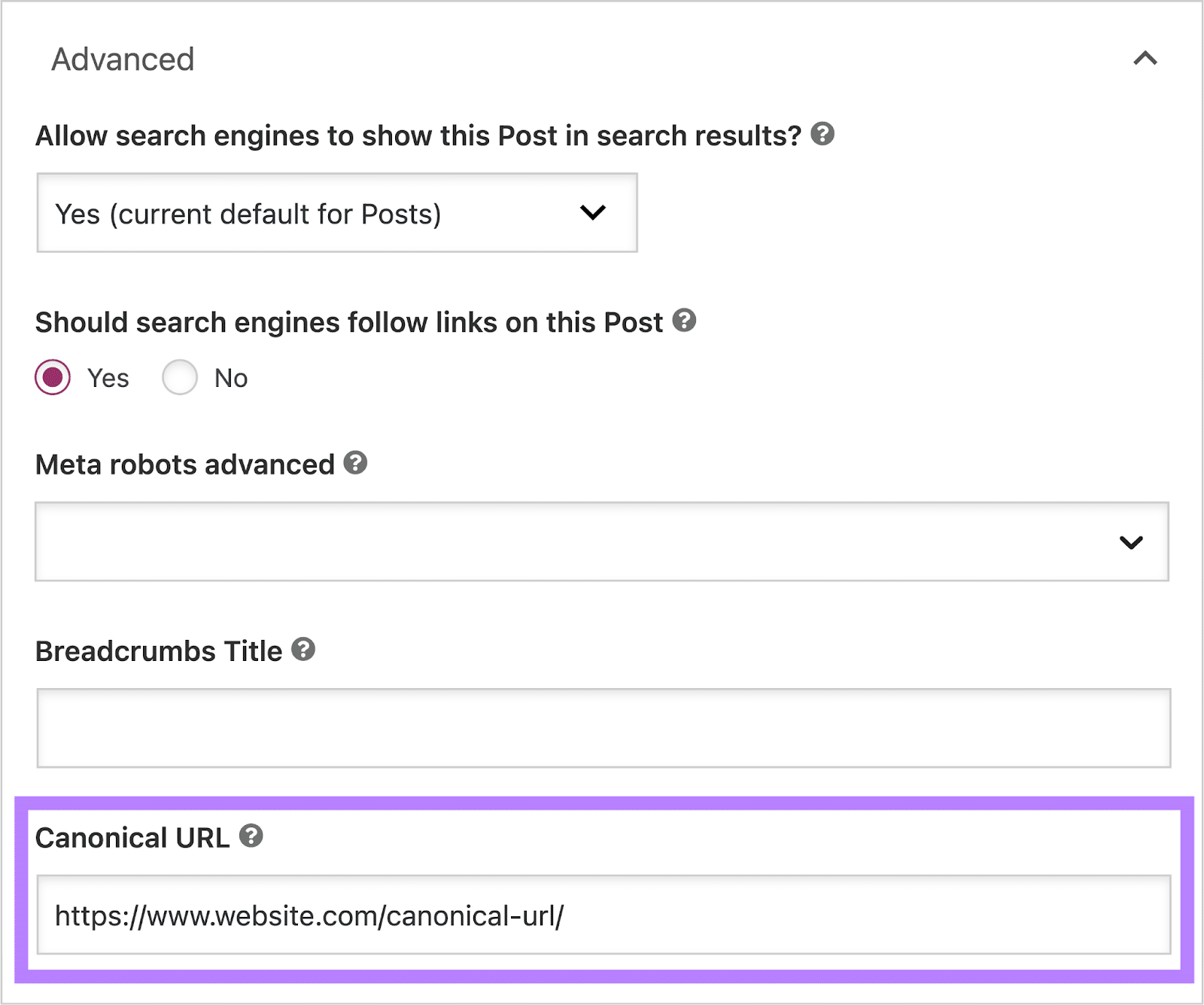
Rank Math search engine optimization Plugin
Should you’re utilizing the Rank Math search engine optimization plugin, head to the “Rank Math search engine optimization” field on any web page or submit. And open the “Superior” tab.
The “Canonical URL” discipline lets you specify the canonical URL for the web page.
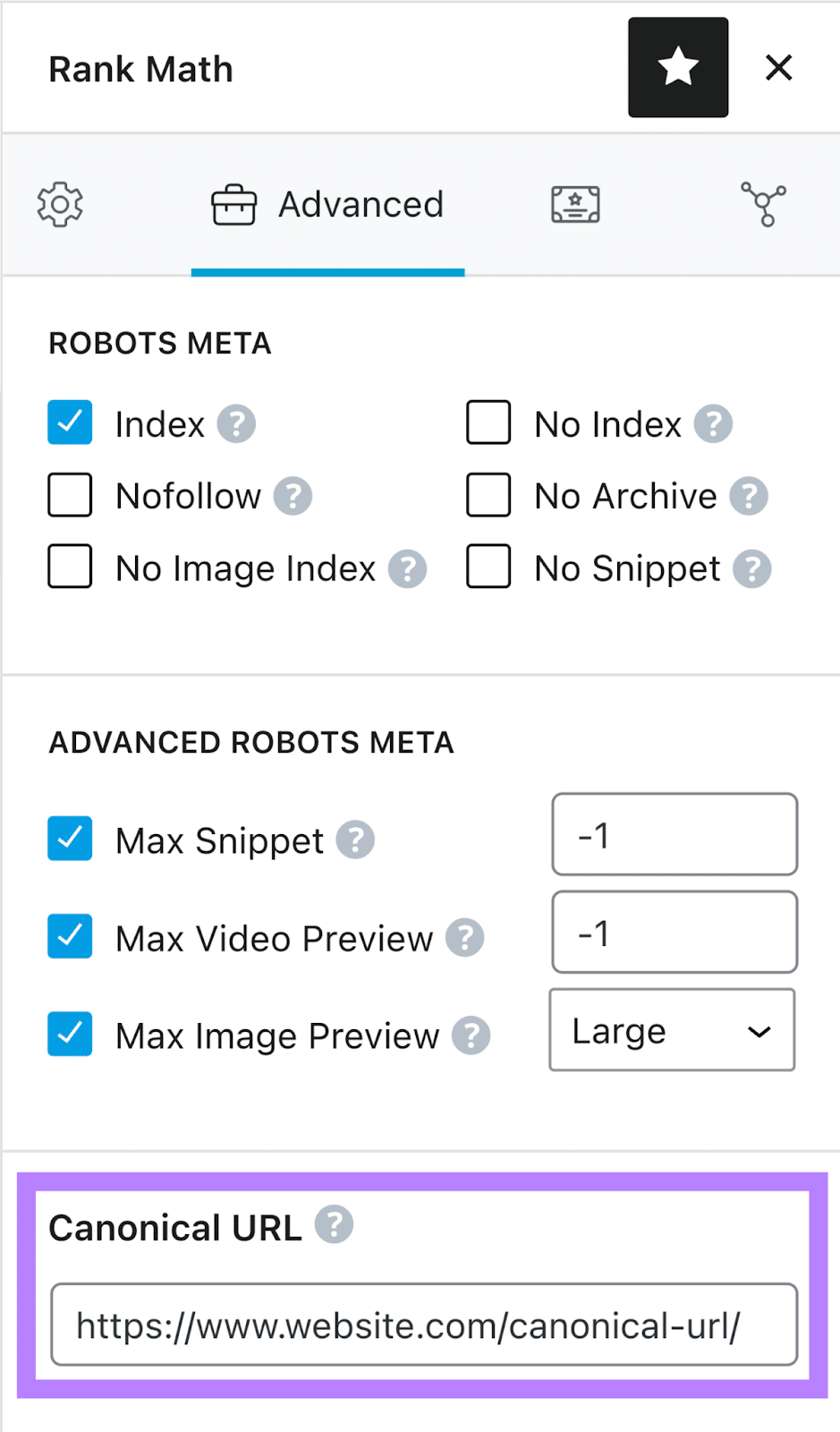
Wix
Wix pages use a self-referencing canonical tag by default.
You may change the construction of your canonical tags by going into your search engine optimization settings.
First, head to “Website & Cell App” > “Web site & search engine optimization” > “search engine optimization.” After which select the kind of web page that you just wish to edit.
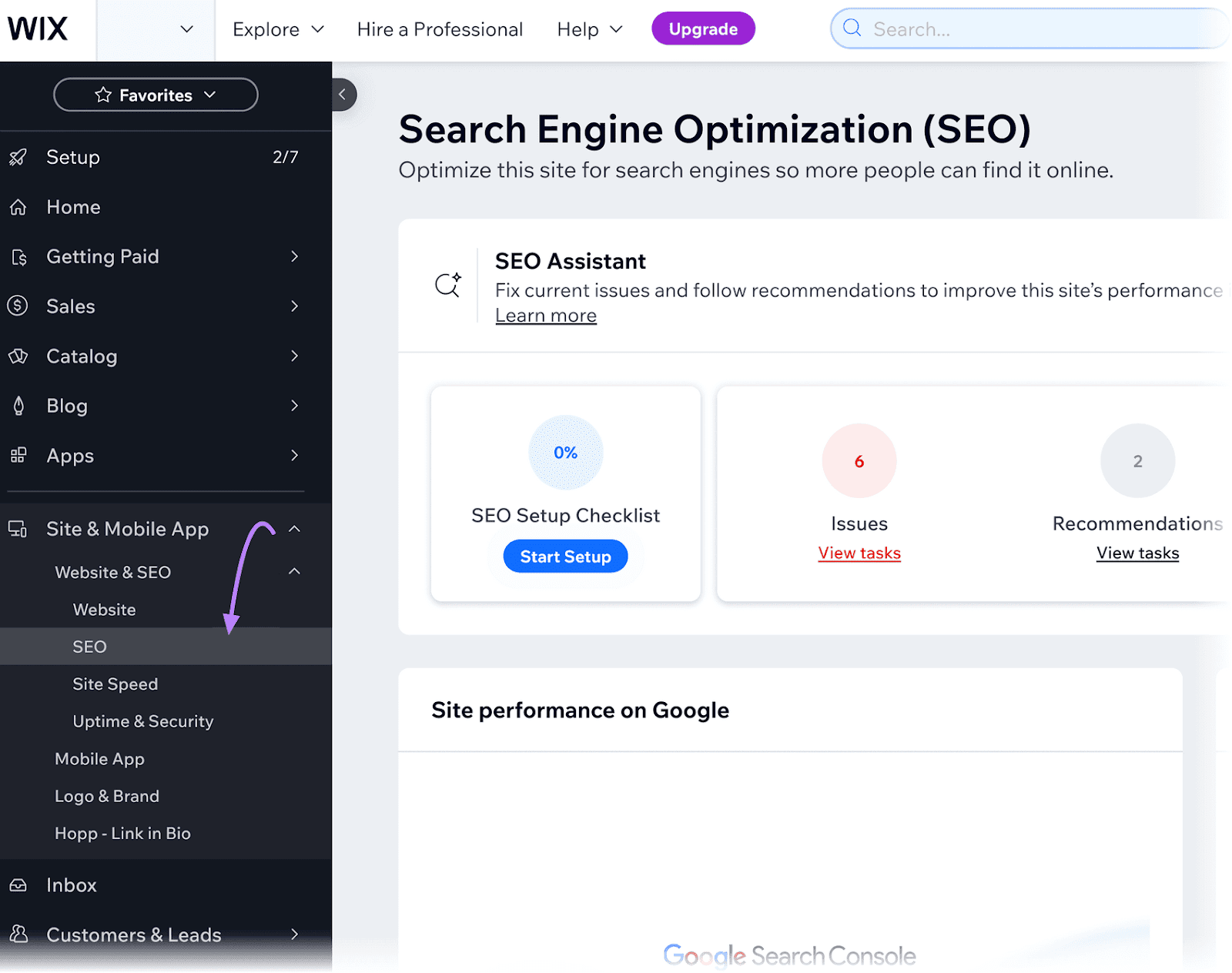
Scroll down till you see “Instruments & Settings” and choose “Go to search engine optimization Settings” from below “search engine optimization Settings.”
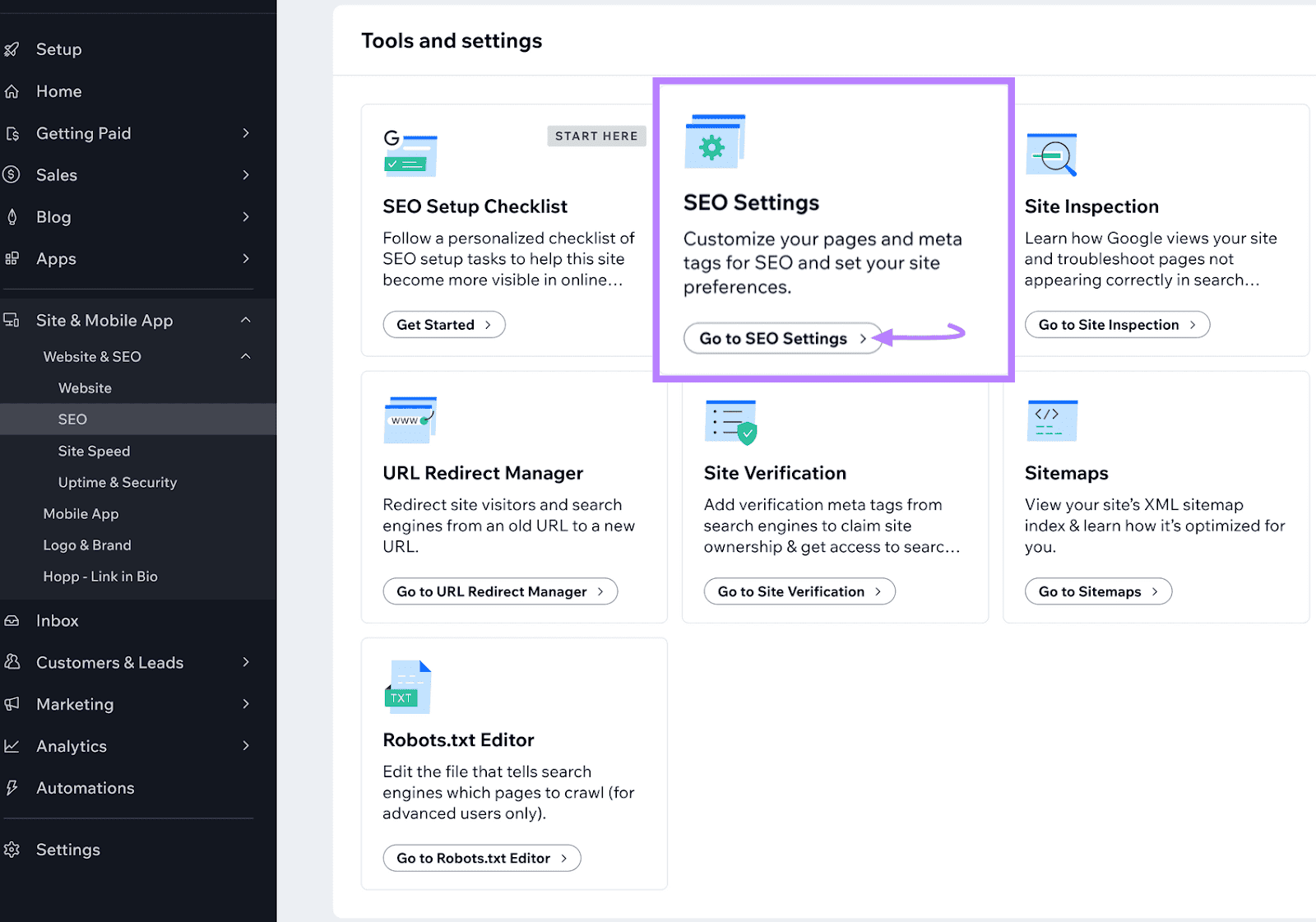
Then, choose the kind of web page you wish to regulate your canonical tags for.
For this workflow, we chosen “Most important Pages.”
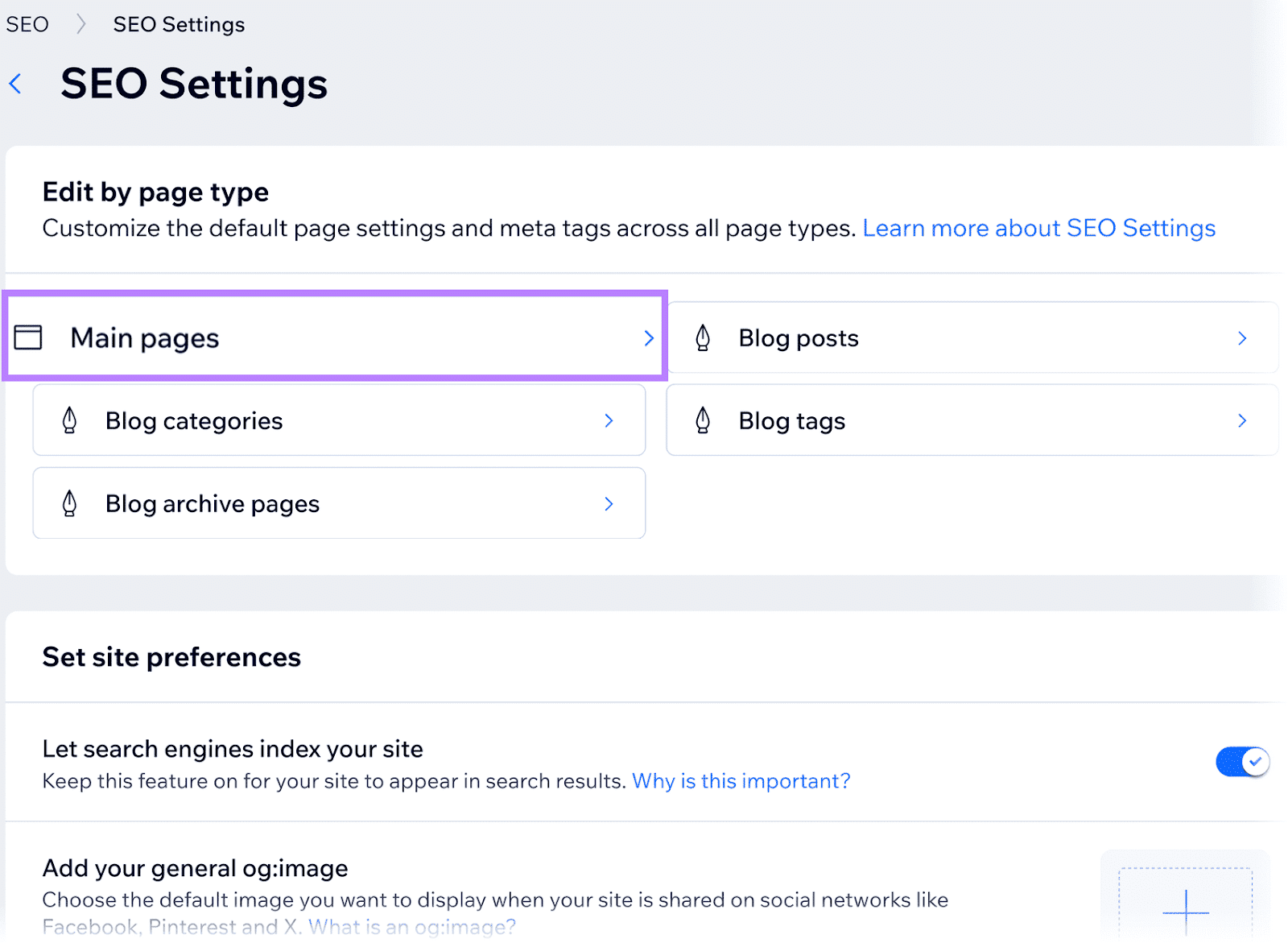
Subsequent, choose the “Edit” button subsequent to “Further Meta Tags.”
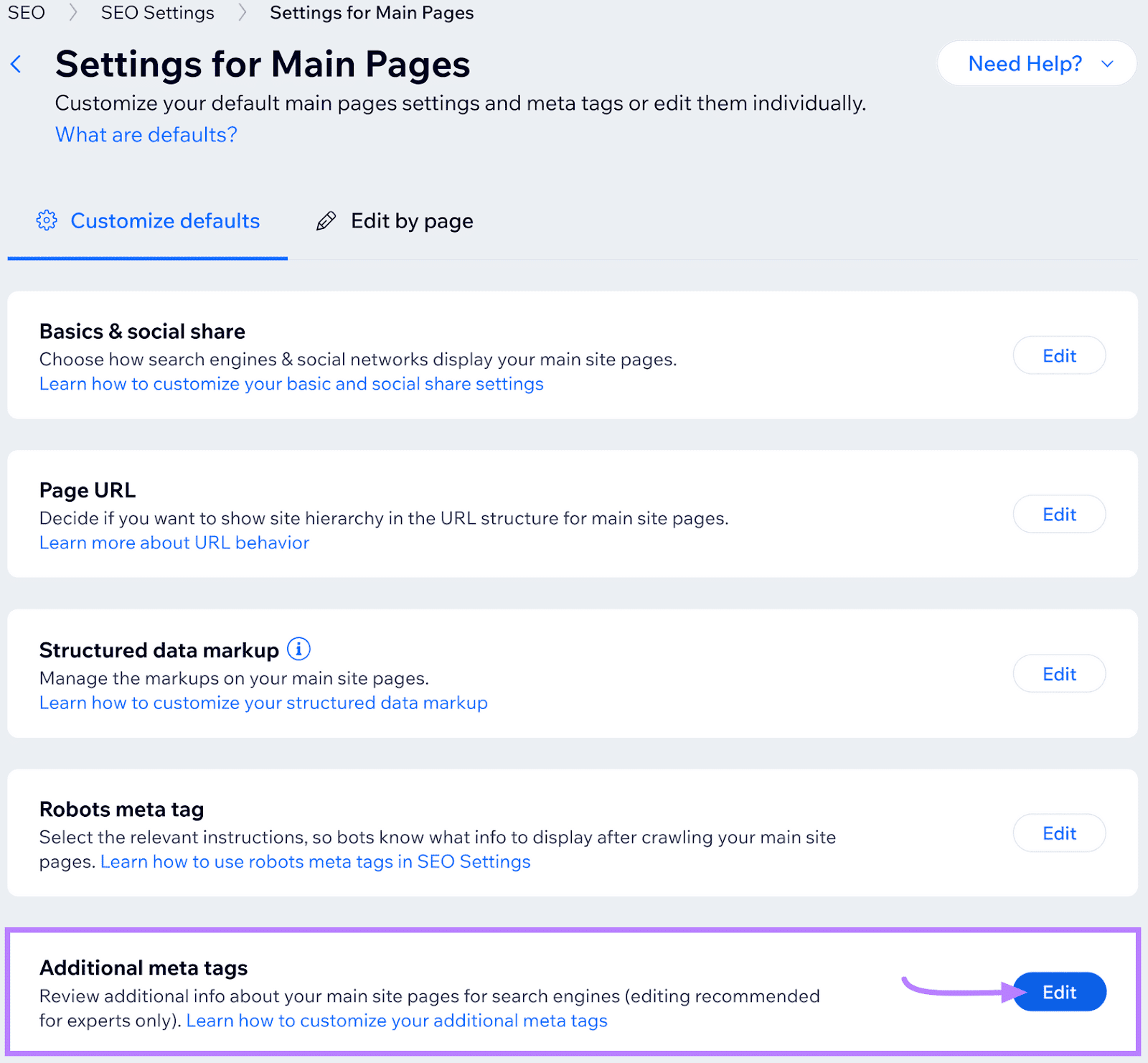
Then, add variables to the sphere below “canonical” by clicking on “+ Add Variable.” And deciding on related gadgets from the record that seems.
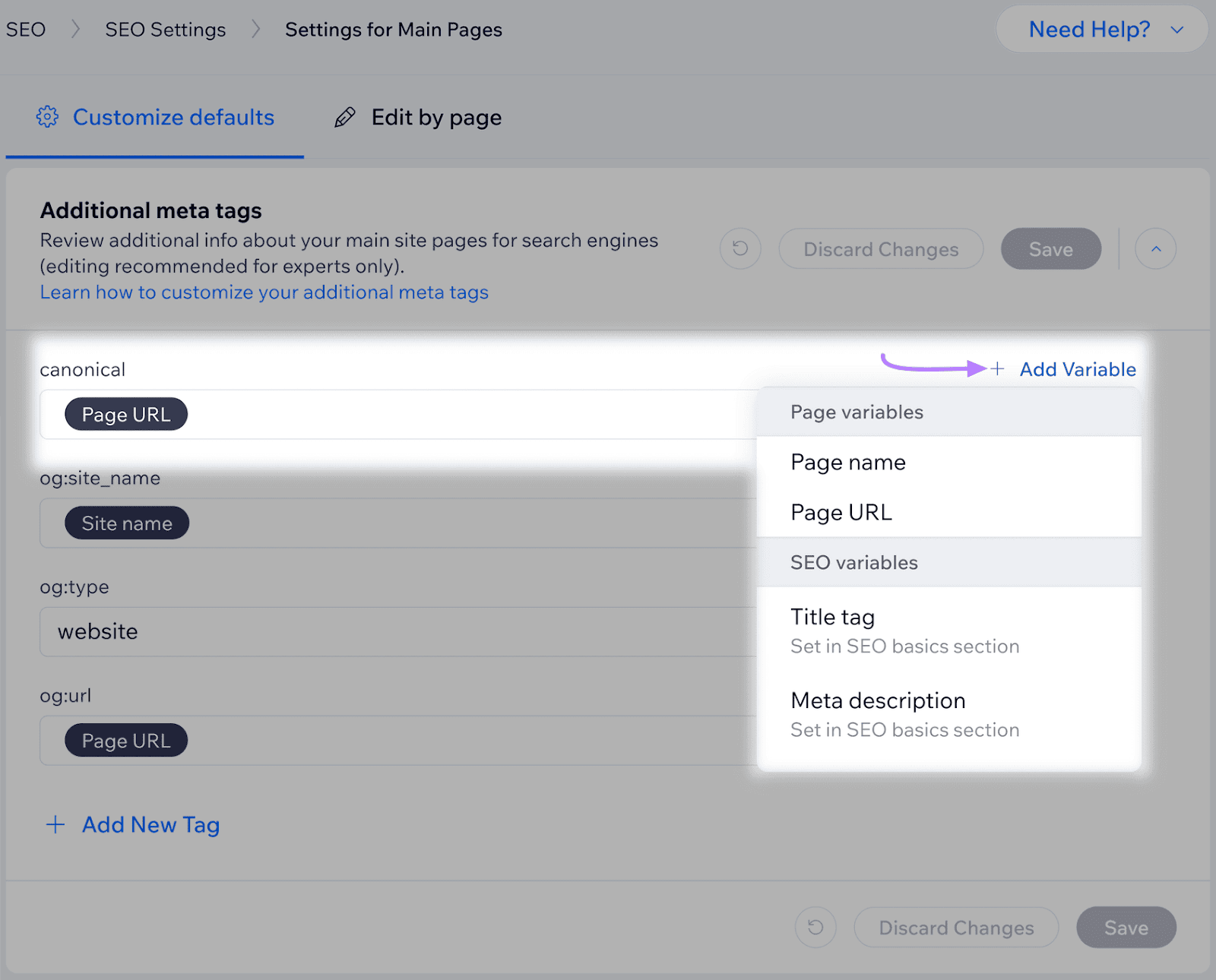
You may as well edit the canonical tags of particular person pages. Simply go to your editor and choose “Pages & Menu” > “Retailer Pages.”
Then, discover the web page you’re targeted on, click on the three-dot icon, and choose “search engine optimization Fundamentals.”
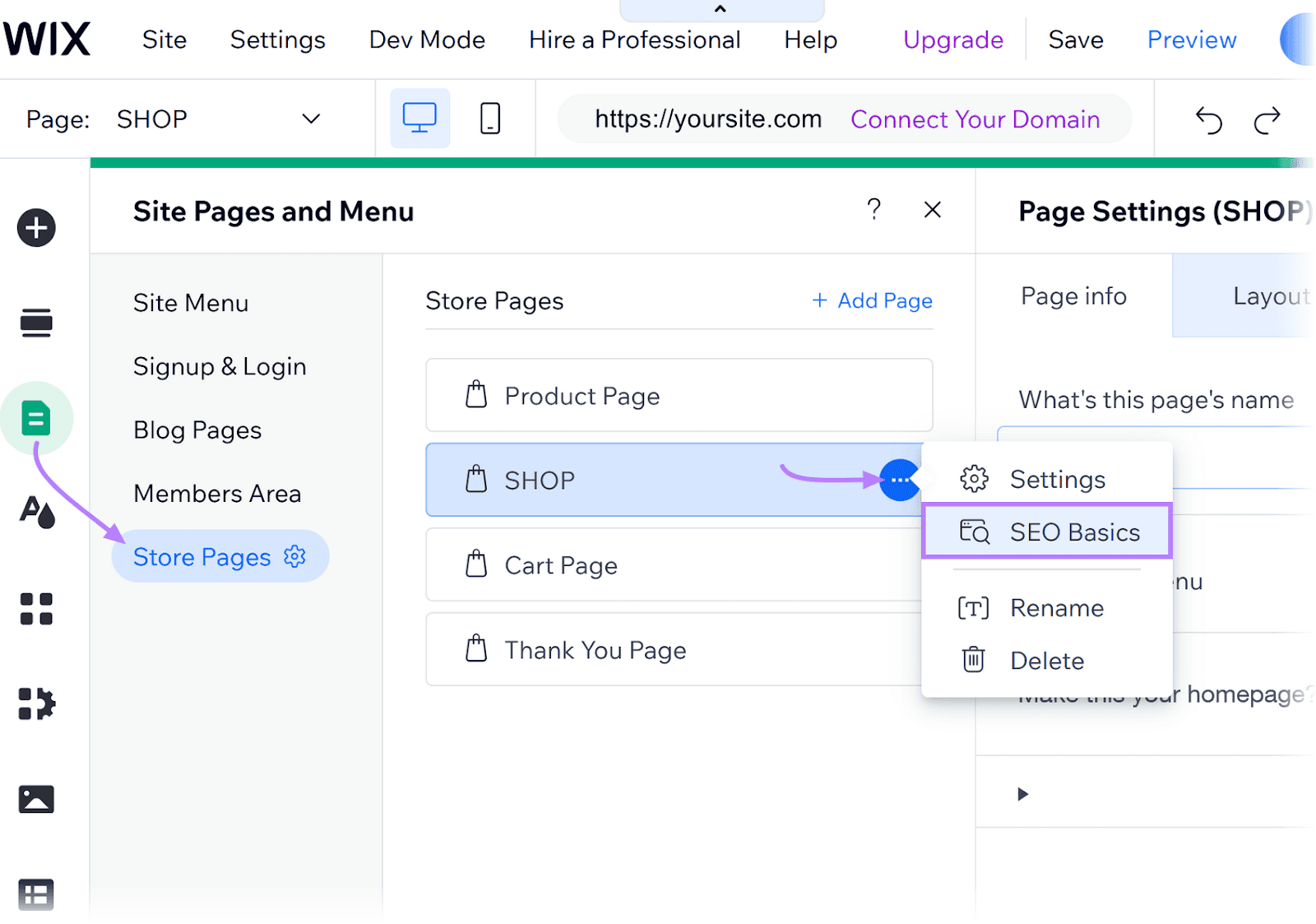
Then, go to “Superior search engine optimization” > “Further Tags.” And regulate the canonical tag in response to your wants.
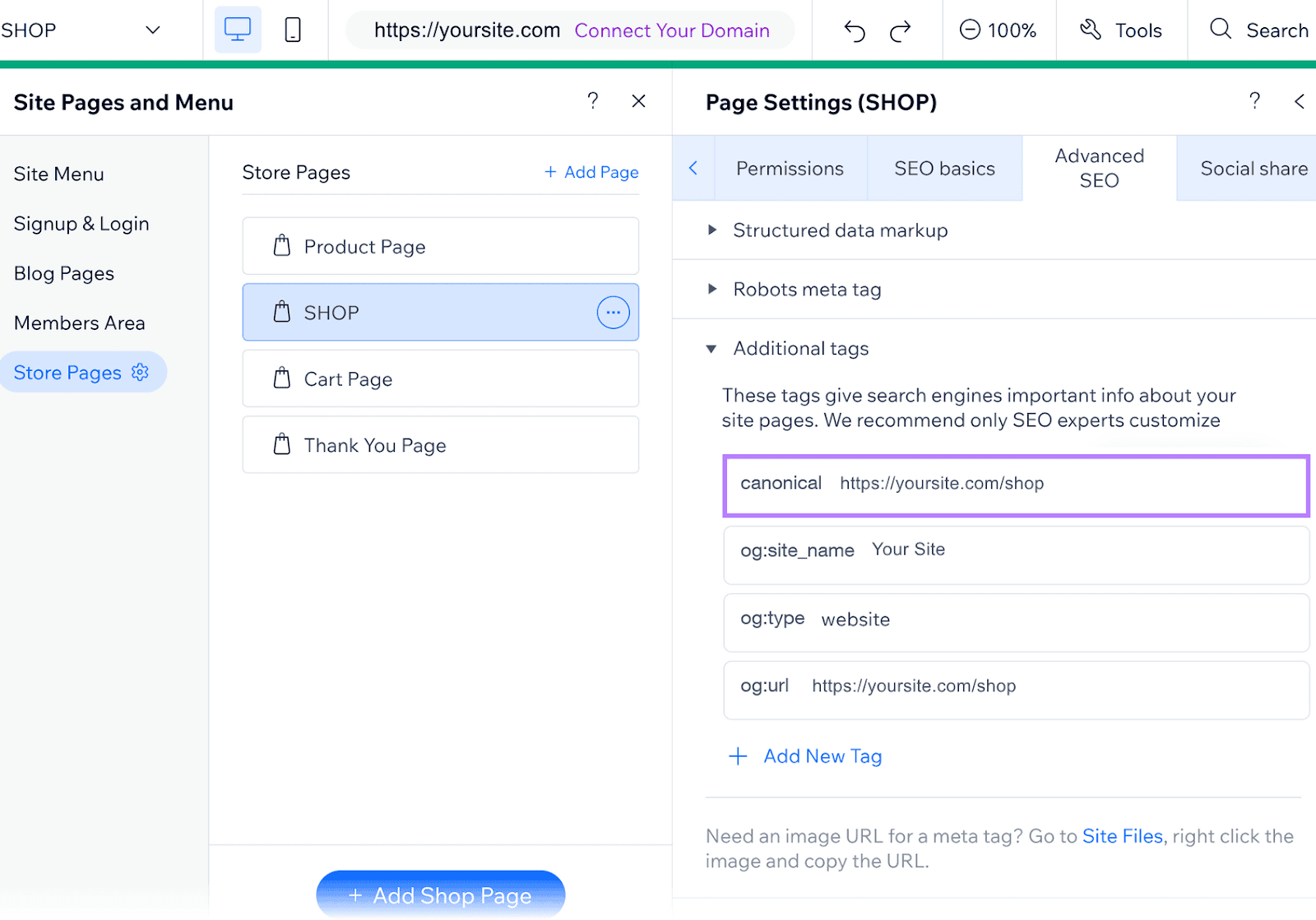
Different Methods to Specify Canonical URLs
Usually, you specify canonical URL preferences utilizing canonical tags. However there are different strategies.
Let’s take a look at these deduplication strategies in additional element.
Use rel=“canonical” in HTTP Headers
A rel=“canonical” HTTP header lets you specify a canonical URL for non-HTML paperwork.
For instance, if in case you have a DOCX and PDF model of the identical doc on-line, you should utilize this technique to point your most well-liked model.
However you want to have the ability to change your server’s configuration.
Within the .htaccess file, specify a canonical URL by including code that appears like this:
Header add Hyperlink: <https://www.instance.com/downloads/filename.pdf>; rel="canonical"
Redirect Duplicate Pages to Canonical Pages
URL redirects ship Google (and customers) from one web page to a different.
Redirecting is the most effective deduplication technique in the event you don’t must hold the alternate variations of the web page. However you don’t wish to delete the URLs altogether.
For instance, when you could have HTTP and HTTPS variations of the identical web page.
Google prefers HTTPS variations. So, it’s good in your search engine optimization to redirect the HTTP model to the HTTPS one.
Google recommends utilizing 3xx redirects (server-side redirects) for the quickest outcomes.
This contains the 301 redirect, which you’ll study extra about in our 301 redirect information.
Record Canonical URLs Solely in Your Sitemap
All of the pages listed in your sitemap point out your steered canonical URLs, in response to Google.
This implies it’s a good suggestion to submit canonical URLs (and non-duplicated pages) solely in your sitemap. And depart alternate URLs out.
It’s not an enormous situation in the event you depart duplicate pages in your sitemap. Google will determine which model is canonical.
Nevertheless it could possibly be an issue in the event you by chance depart most well-liked URLs out. So, hold your sitemap up to date.
Canonical Tags: search engine optimization Finest Practices
Should you don’t implement canonicals appropriately, Google would possibly ignore them. And that may hurt your search engine optimization efficiency.
So, comply with these canonical tag greatest practices for the most effective outcomes:
Specify One Canonical URL Per Web page
Solely specify one canonical URL per web page. In any other case, you’ll confuse Google.
Watch out to not by chance embody two canonical tags inside your web page’s HTML code. Should you set the canonical tag utilizing a setting in your CMS, do not manually add further canonical tags to your HTML.
And in the event you add rel=”canonical” to the HTML, don’t additionally add it to the HTTP header.
Specify the Appropriate Area Protocol
In case your web site sits on the HTTPS protocol, you’ll want to reference this as your canonical URL.
Try our information to study extra about redirecting from HTTP to HTTPS.
Specify Trailing Slash or Non-Trailing Slash URLs
Take note of whether or not your pages use trailing slashes (i.e., “/” symbols on the finish of URLs).
For instance:
- Trailing slash: https://instance.com/
- Non-trailing slash: https://instance.com
If the identical URL exists with each the trailing slash and with out, Google might even see them as two separate URLs. So, you’ll want to reference your canonical URL appropriately by together with the trailing slash if wanted.
And attempt to be constant throughout your web site.
Specify Non-WWW or WWW URLs
Engines like google see non-WWW and WWW variations of a URL as duplicate pages.
For instance:
- Non-WWW: https://instance.com/
- WWW: https://www.instance.com/
It’s greatest to decide on one model and keep it up throughout your complete web site.
Use Absolute URLs
Canonical tags needs to be referenced utilizing absolute URLs quite than relative URLs.
Meaning you need to use the complete URL, together with your area. Like this:
<hyperlink rel="canonical" href="https://instance.com/weblog/" />
And never a relative URL. Like this:
<hyperlink rel="canonical" href="/weblog/" />
Widespread Errors to Keep away from When Implementing Canonical Tags
It’s simple to make errors when implementing canonical tags.
Listed below are a few of the extra widespread canonical tag errors:
Pointing Canonical Tags to Redirected Pages
Watch out to not specify a canonical URL that redirects. This can solely confuse Google.
For instance, let’s say Web page A redirects to Web page B.
You shouldn’t have any canonicals that time to Web page A. They need to level on to Web page B as a substitute.
Utilizing Canonical Tags for Non-Duplicate Content material
Solely set canonical URLs for duplicate or near-identical content material.
Some SEOs attempt to use canonical tags to consolidate the rating energy of dissimilar pages. Like directing authority from out-of-stock product pages to class pages.
However Google advises towards this observe. And is very more likely to ignore these canonicals.
You additionally is likely to be tempted to make use of canonical tags for related merchandise. However even when two merchandise are alike (like two completely different fashions of headphones), they need to each have their very own units of canonical tags.
If Google honors these canonical tags, customers could battle to find related merchandise. And that may negatively influence your gross sales.
Putting Canonical Tags within the Improper Place
Canonical tags have to be within the <head> part of your HTML.
Should you put them within the fallacious place, search engines like google and yahoo may not discover or acknowledge them. And your pages would possibly find yourself competing towards one another in search outcomes.
To double-check that your placement is appropriate for any web page, go to that web page’s URL, right-click on the web page, and choose “View Web page Supply.”
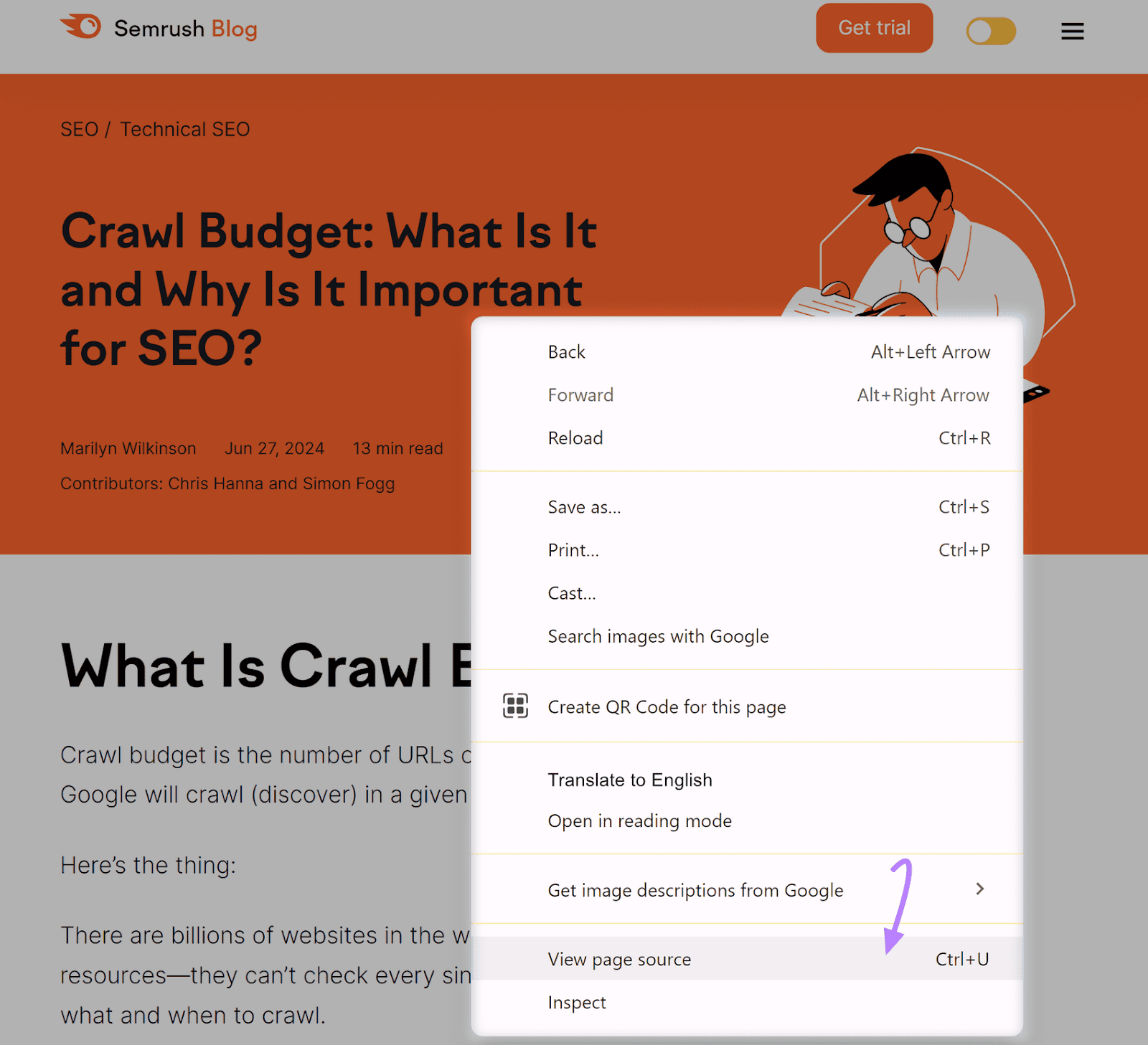
Then, kind Command + F (on a mac) or Ctrl + F (on a PC), and enter “canonical.”
It’s best to then have the ability to see whether or not it’s situated within the correct place.
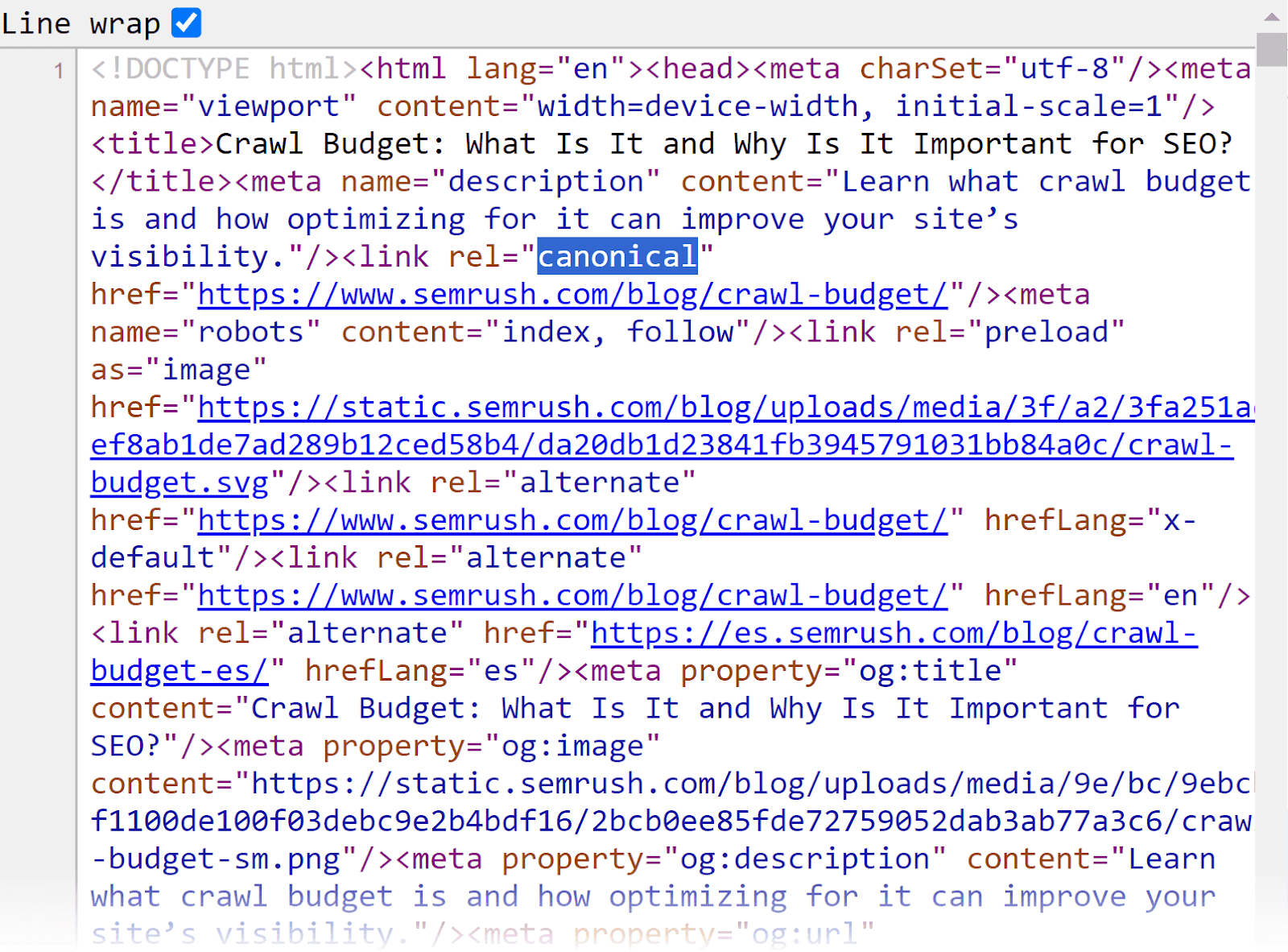
If it is not within the <head> part, you’ll wish to transfer it there.
Having Conflicting Canonical and Hreflang Tags
When you could have a multilingual web site, you will typically use each canonical tags and hreflang tags (HTML that specifies a web page’s language and generally its location).
Canonical tags inform search engines like google and yahoo which model of a web page is the primary one.
Hreflang tags inform search engines like google and yahoo which language you are utilizing on a selected web page. To make sure the fitting model is proven to customers in numerous nations.
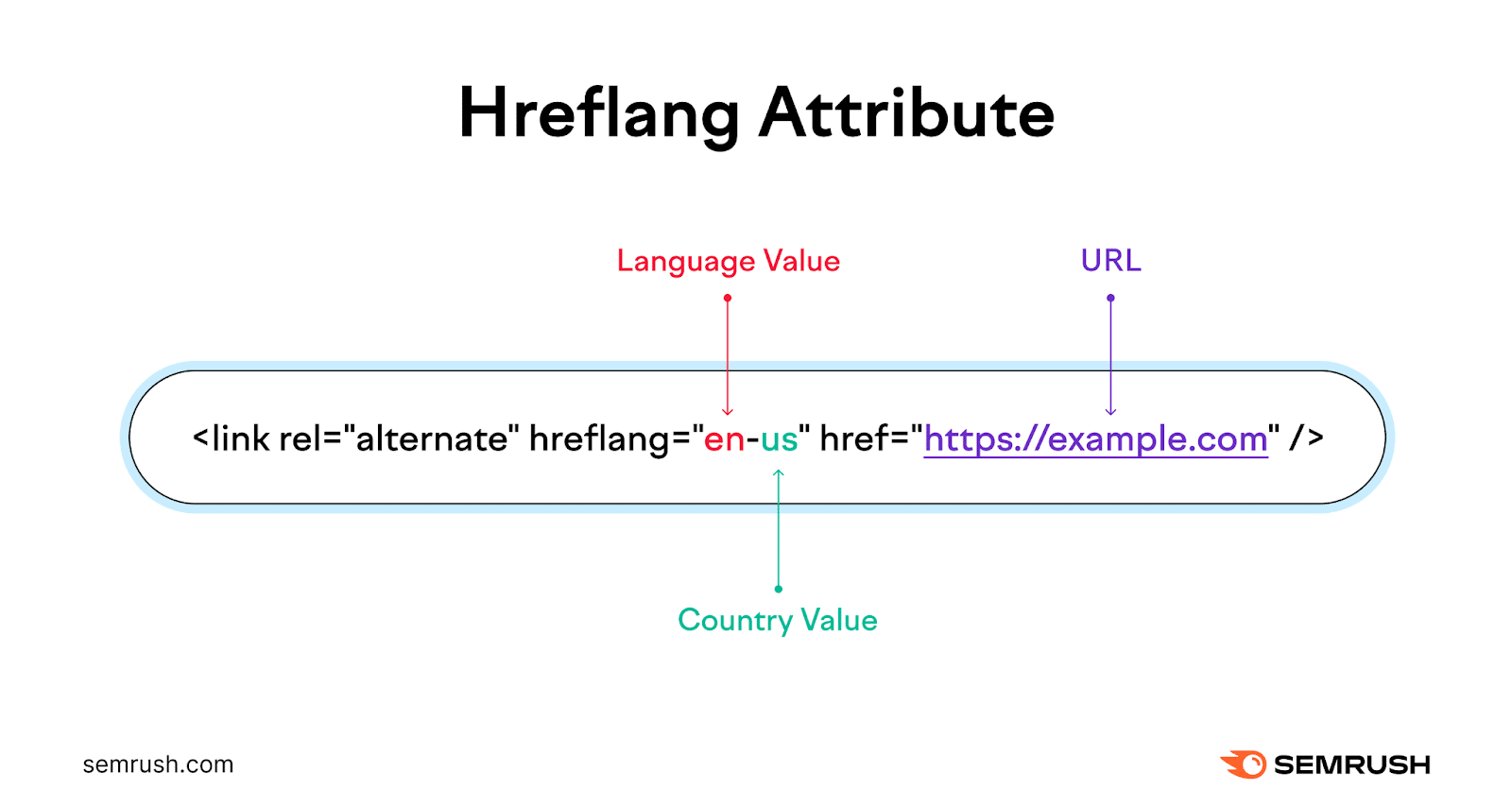
For instance you could have a web page about cats in three languages.
- English: https://instance.com/cats
- Spanish: https://instance.com/es/gatos
- French: https://instance.com/fr/chats
A standard mistake can be to record “https://instance.com/cats” because the canonical URL on every web page.
That sends conflicting messages to Google. And will consequence within the fallacious language model being proven to customers in a given nation.
To implement each tags appropriately, every web page ought to declare itself as the primary model in its language. And record all accessible language variations, together with itself.
On the English web page, you’d use:
<hyperlink rel="canonical" href="https://instance.com/cats" />
<hyperlink rel="alternate" hreflang="en" href="https://instance.com/cats" />
<hyperlink rel="alternate" hreflang="es" href="https://instance.com/es/gatos" />
<hyperlink rel="alternate" hreflang="fr" href="https://instance.com/fr/chats" />
On the Spanish web page, you’d use:
<hyperlink rel="canonical" href="https://instance.com/es/gatos" />
<hyperlink rel="alternate" hreflang="en" href="https://instance.com/cats" />
<hyperlink rel="alternate" hreflang="es" href="https://instance.com/es/gatos" />
<hyperlink rel="alternate" hreflang="fr" href="https://instance.com/fr/chats" />
On the French web page, you’d use:
<hyperlink rel="canonical" href="https://instance.com/fr/chats" />
<hyperlink rel="alternate" hreflang="en" href="https://instance.com/cats" />
<hyperlink rel="alternate" hreflang="es" href="https://instance.com/es/gatos" />
<hyperlink rel="alternate" hreflang="fr" href="https://instance.com/fr/chats" />
Easy methods to Audit Canonical Tags on Your Website
Discover out what Google considers to be the canonical URL for any web page in your web site with Google Search Console.
After logging in, seek for a URL on the high.
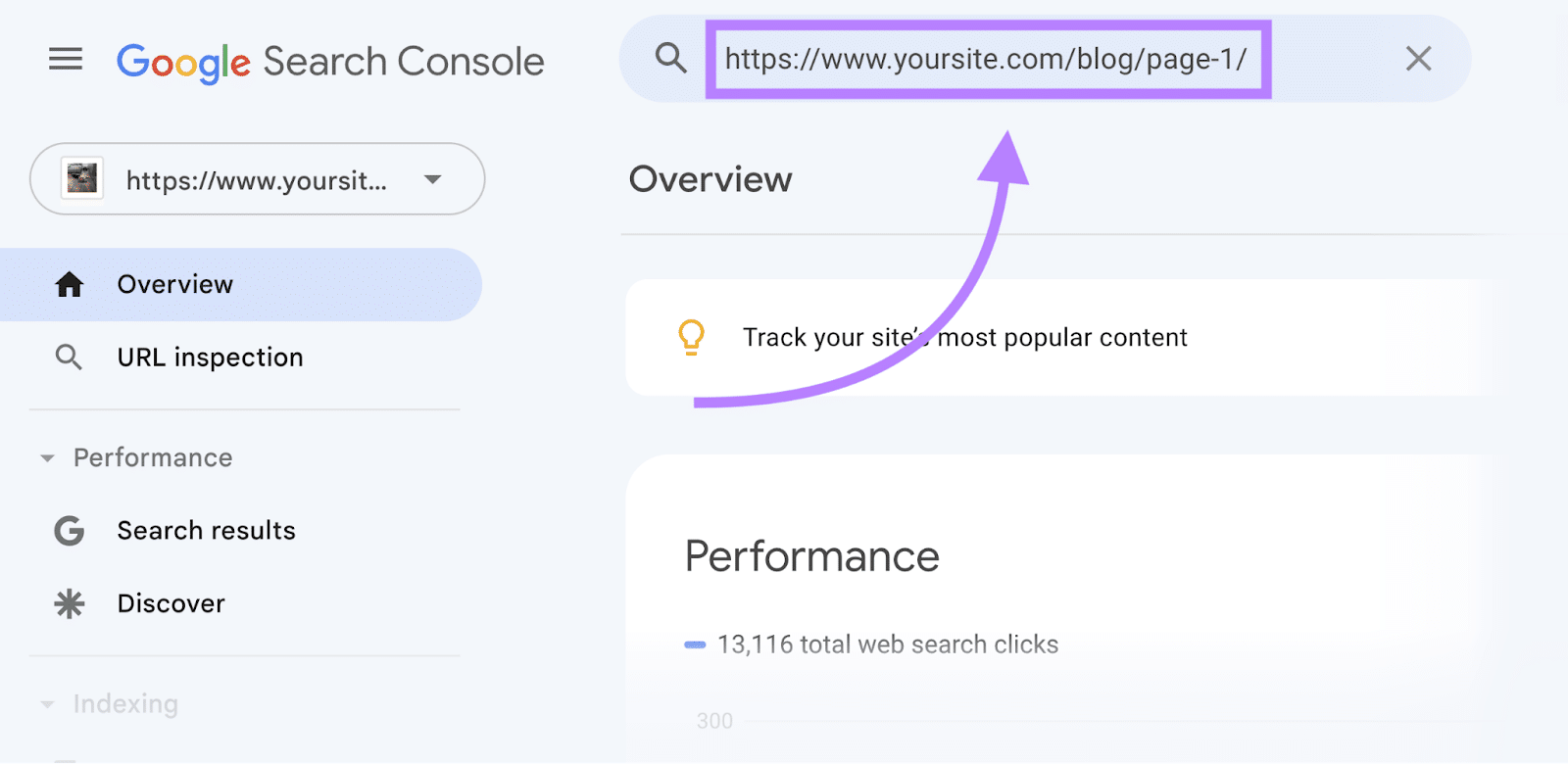
When the “URL Inspection” report is prepared, open the “Web page indexing” part.
Scroll all the way down to see the “Google-selected canonical.”
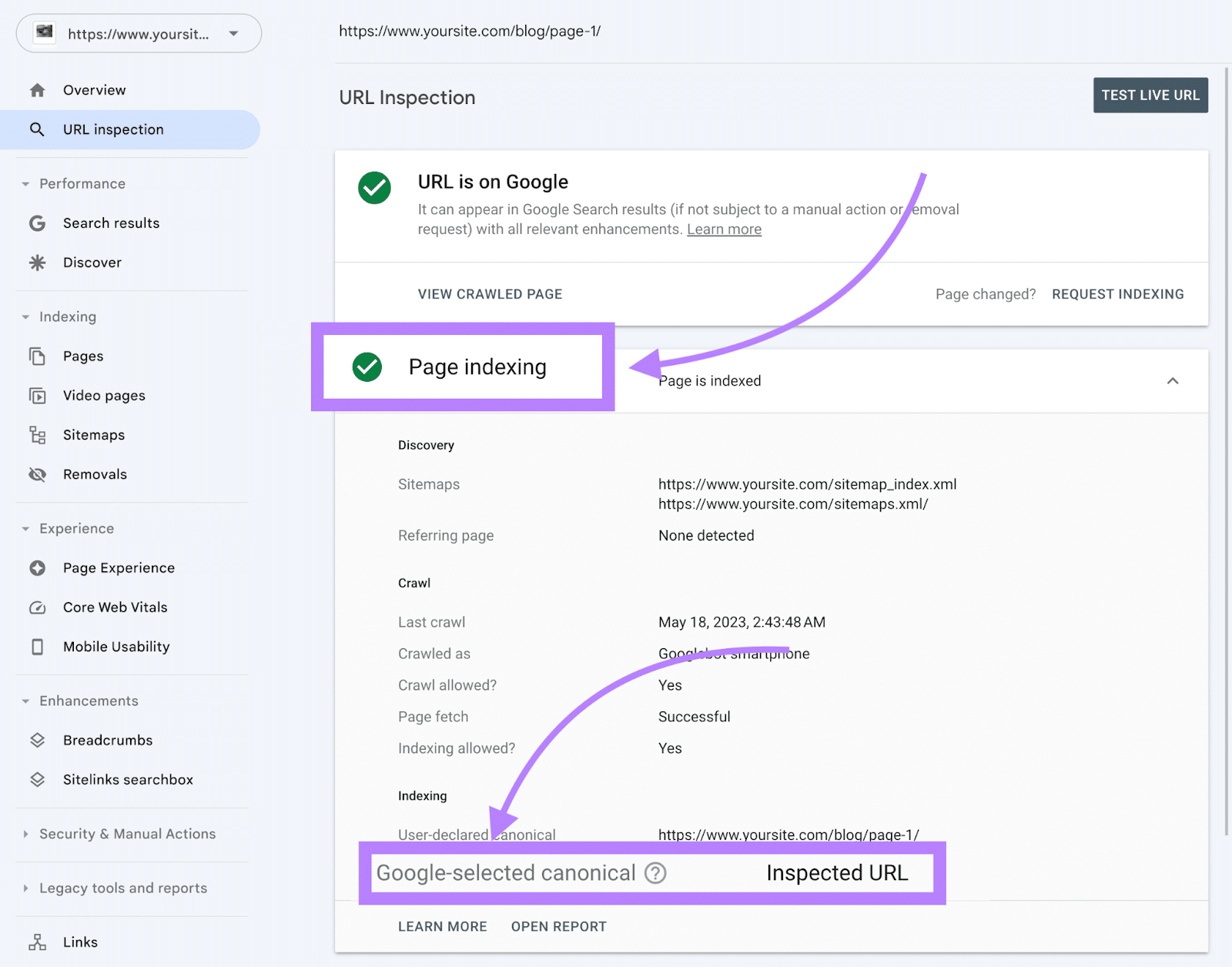
If this isn’t your most well-liked URL, you might must evaluate your deduplication efforts.
To start out, make it possible for the “Person-declared canonical” is current and proper.
To audit your web site’s canonical tags at scale, use Semrush’s Website Audit software.
Open the software, enter your area, and click on “Begin Audit.”
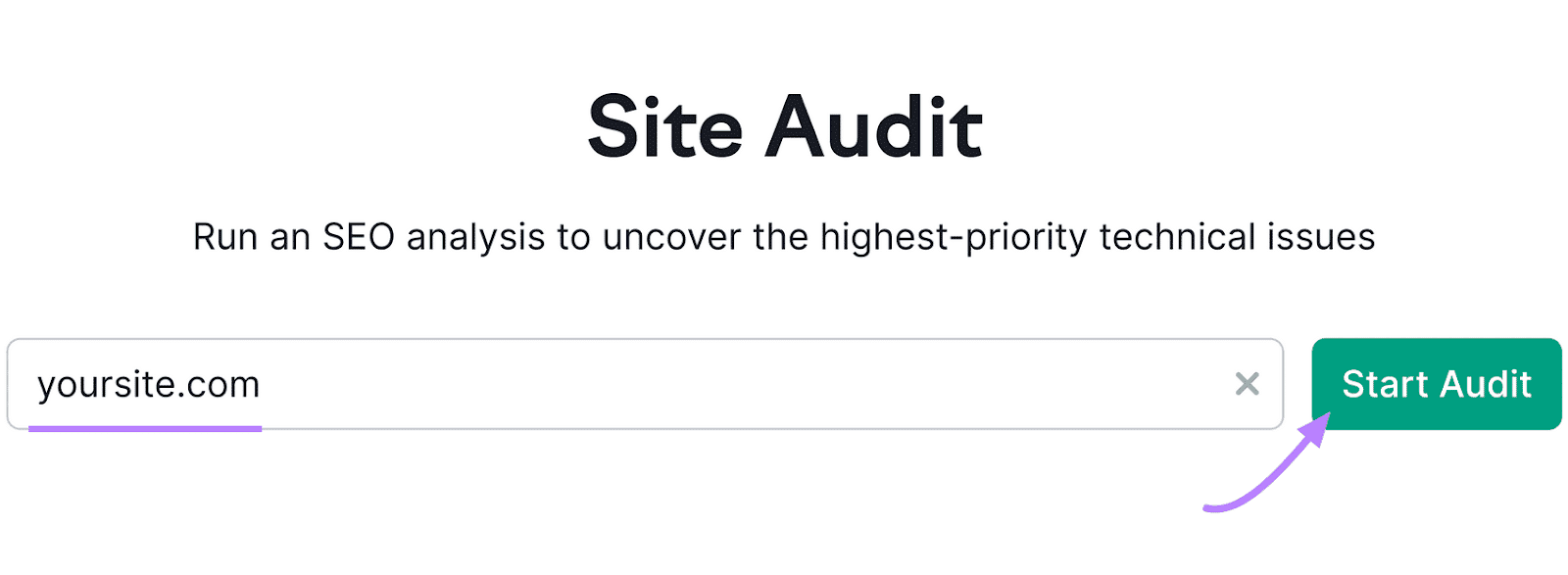
Configure your Website Audit Settings to arrange your crawl. And goal to crawl as many pages as attainable—to make sure you don’t miss any points.
Verify the field subsequent to “Ship an electronic mail each time an audit is full.” And click on “Begin audit.”

When the audit is completed, go to the “Points” tab. And search “canonical.”
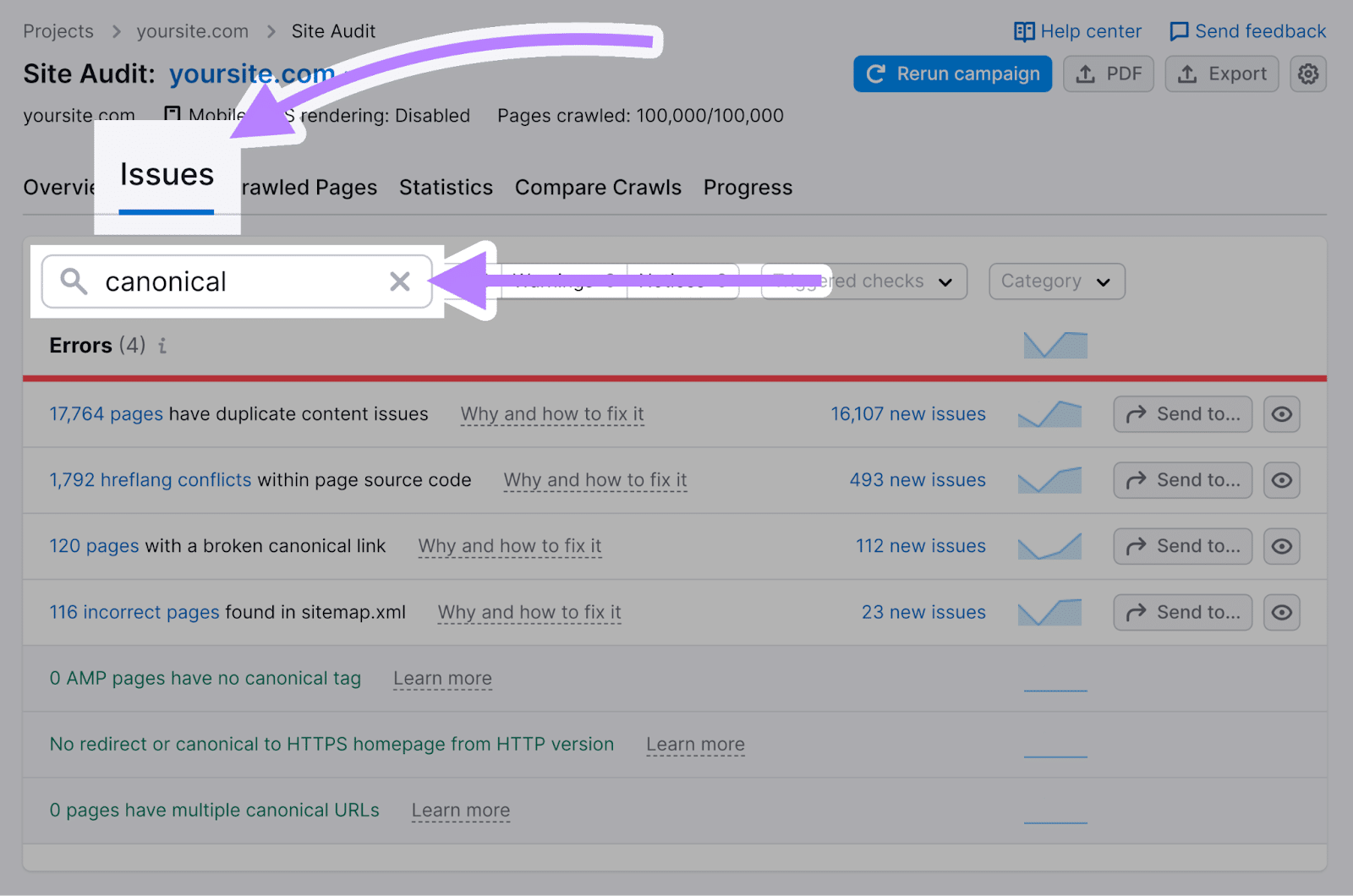
Verify for the next errors:
- # pages have duplicate content material points
- # pages have a number of canonical URLs
- # pages with a damaged canonical hyperlink
- # AMP pages don’t have any canonical tag
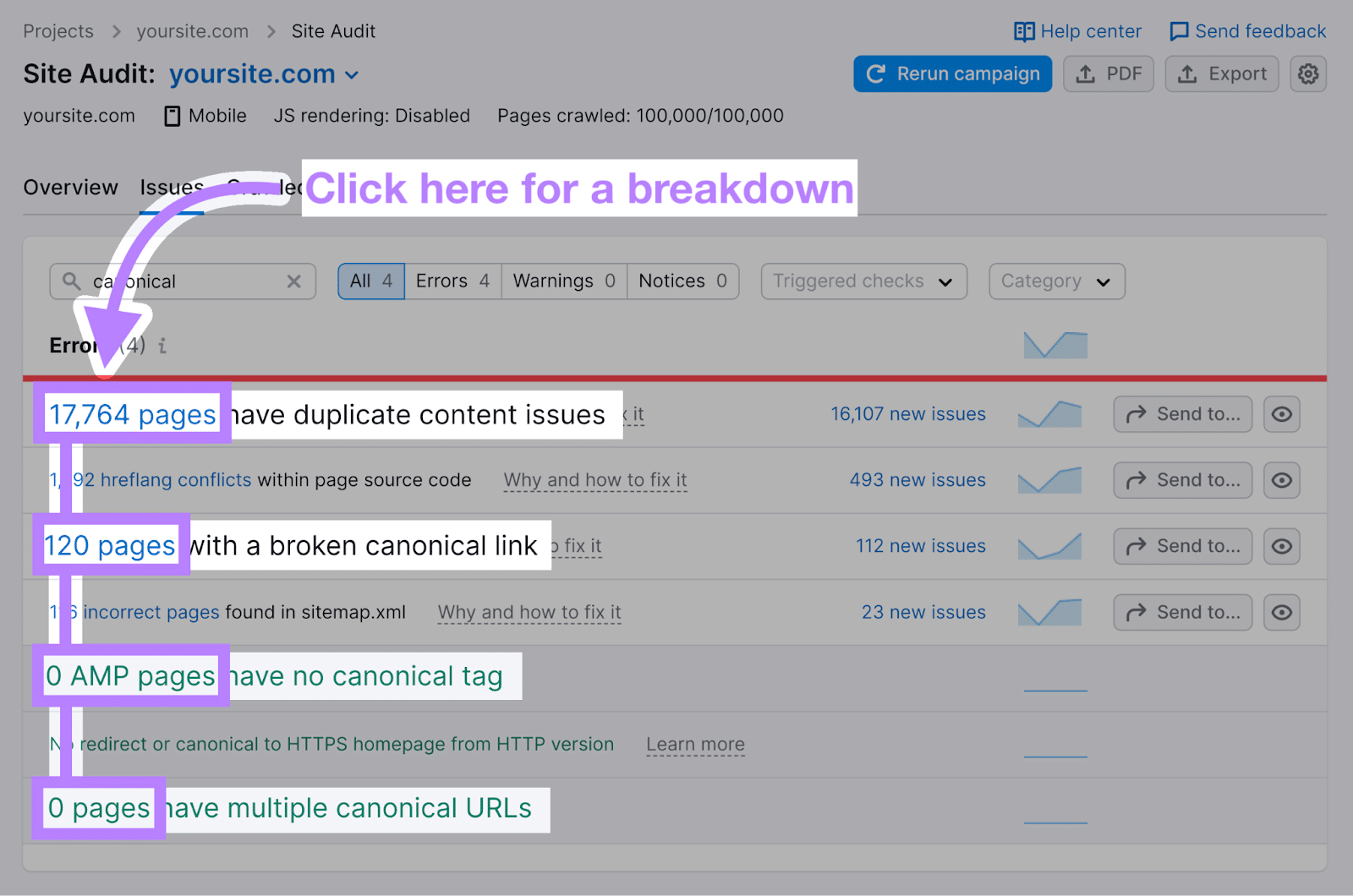
Let’s take a look at what these points are and the way to repair them.
# Pages Have Duplicate Content material Points
This error exhibits what number of pages in your web site could possibly be thought of duplicates. As a result of they characteristic content material that’s not less than 85% similar to the content material on one other web page.
Click on the hyperlink to see affected URLs.
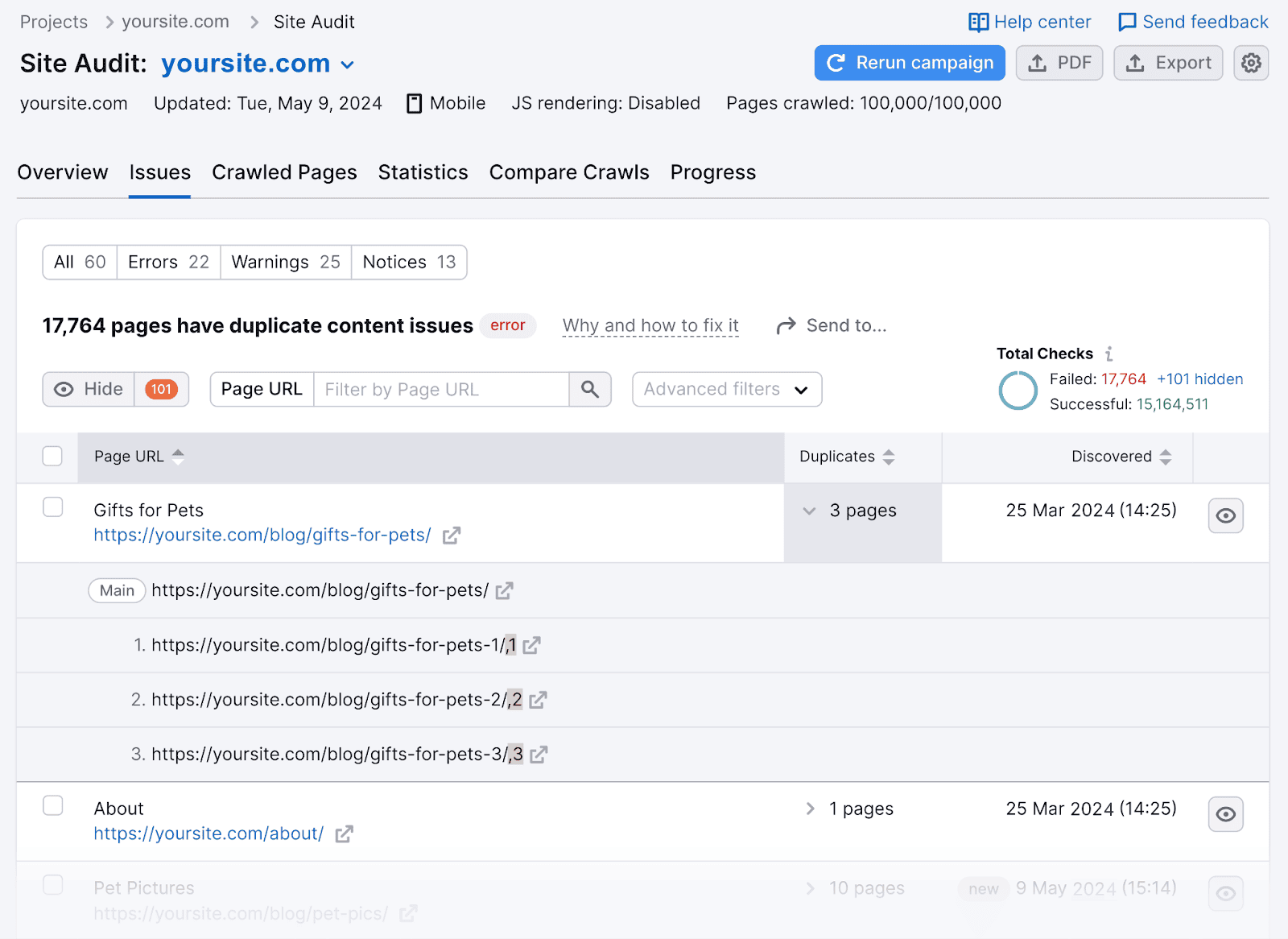
You may then determine the way to resolve the problem. See our duplicate content material information for recommendation.
# Pages Have A number of Canonical URLs
This error exhibits what number of pages in your web site specify a couple of canonical URL.
Click on the hyperlink to view an in depth breakdown.

To repair this situation, take away the additional canonical tag(s). And depart only one in place.
# Pages with a Damaged Canonical Hyperlink
This situation exhibits which pages in your web site have damaged canonical hyperlinks—i.e., specify a canonical URL that doesn’t work.
(Maybe as a result of it incorporates a typo. Or the web page has been deleted.)
Click on the hyperlink to see the affected pages and the canonical URLs they level to.
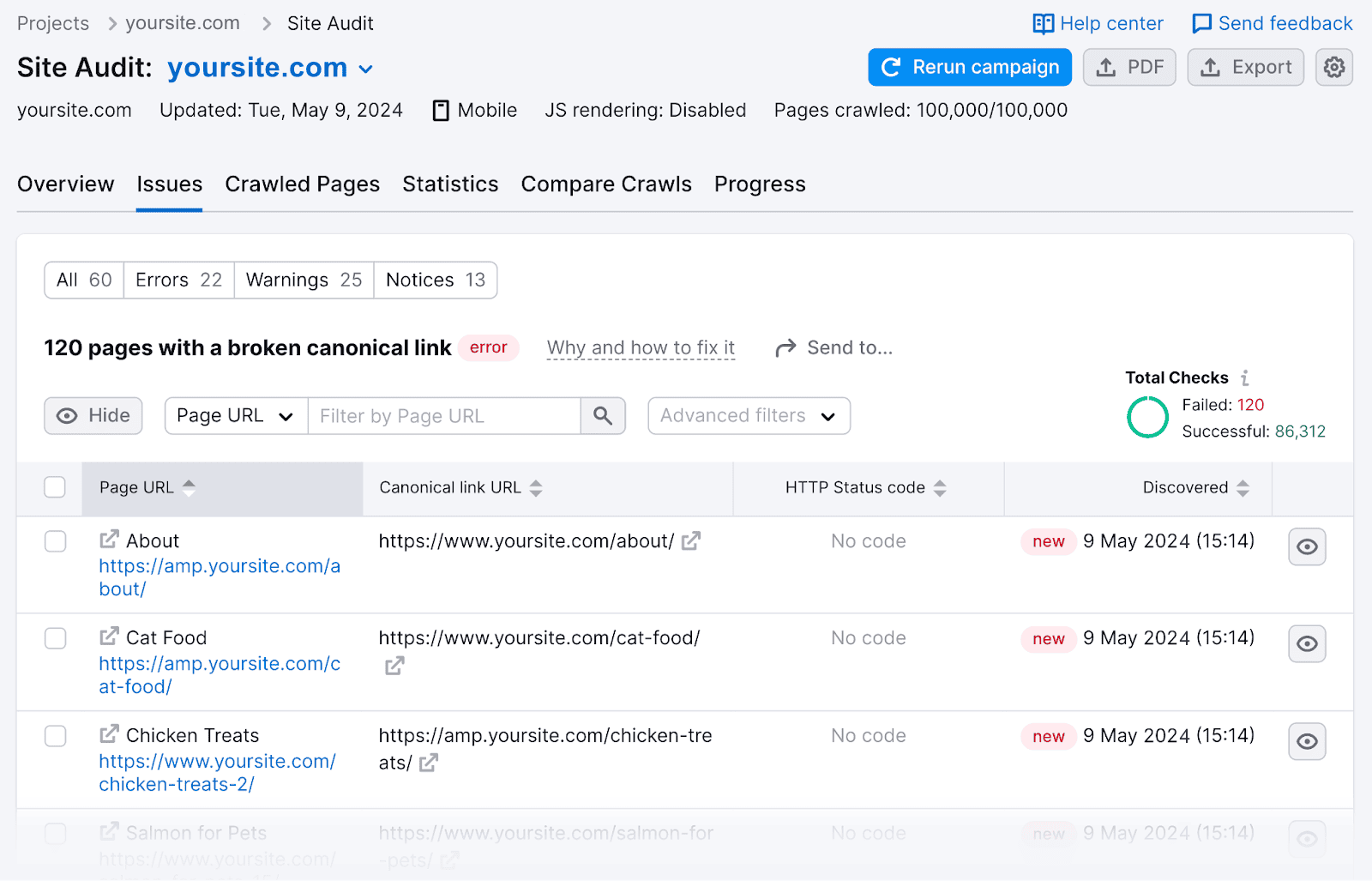
Canonical tags that time to non-existent webpages complicate Google’s capacity to crawl and index your content material correctly. That might hurt your rankings.
So, be sure to replace these to the right canonical URLs.
# AMP Pages Have No Canonical Tag
When your AMP pages don’t have canonical tags, the Website Audit software flags it as a difficulty. It’s essential that canonicalization be in place between AMP and non-AMP variations of your web page.
You may repair this downside by including a rel=”canonical” tag within the <head> part of every AMP web page that factors again to the non-AMP web page.
Like this:
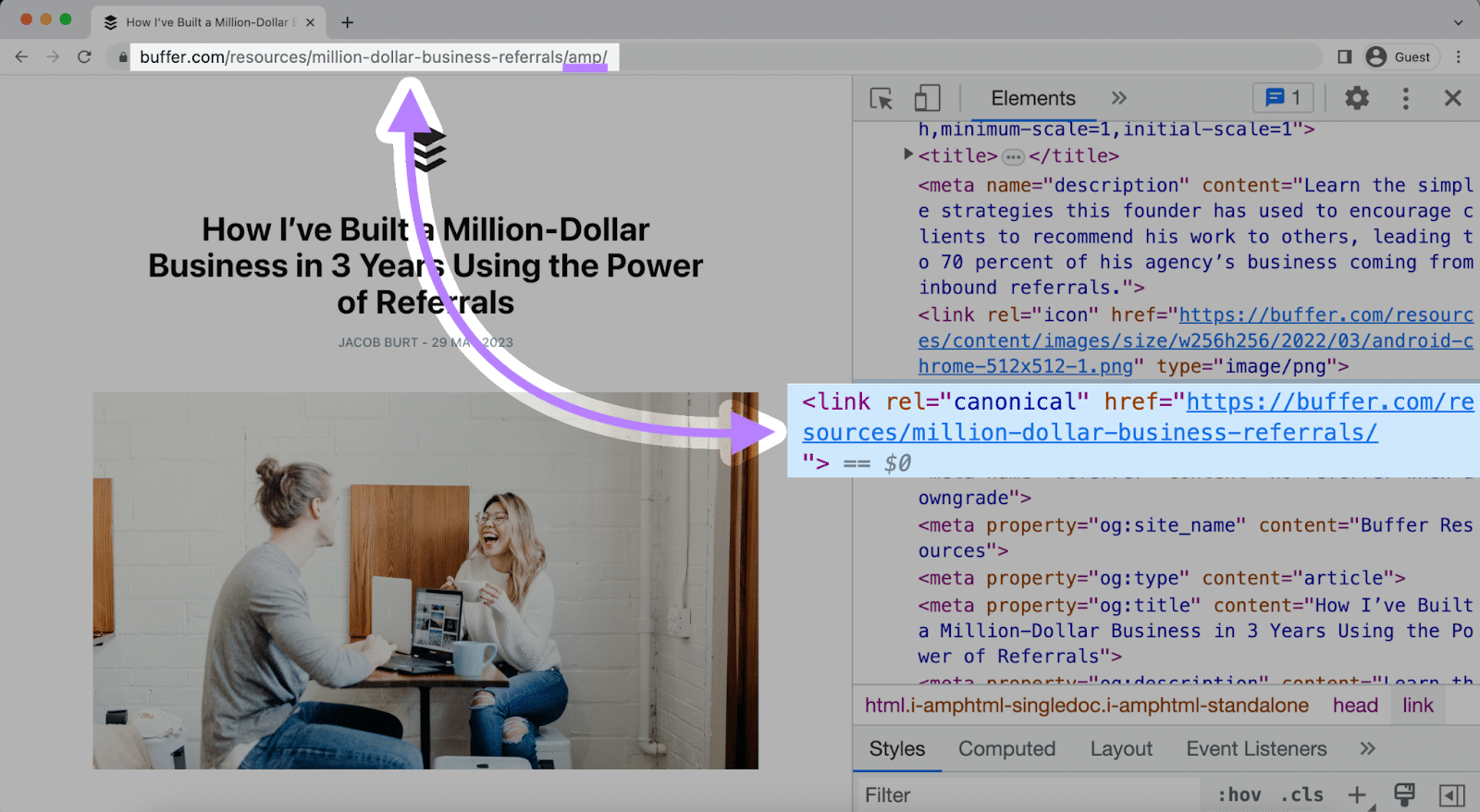
While you’ve mounted this and some other points, rerun the Website Audit utilizing the gear icon.
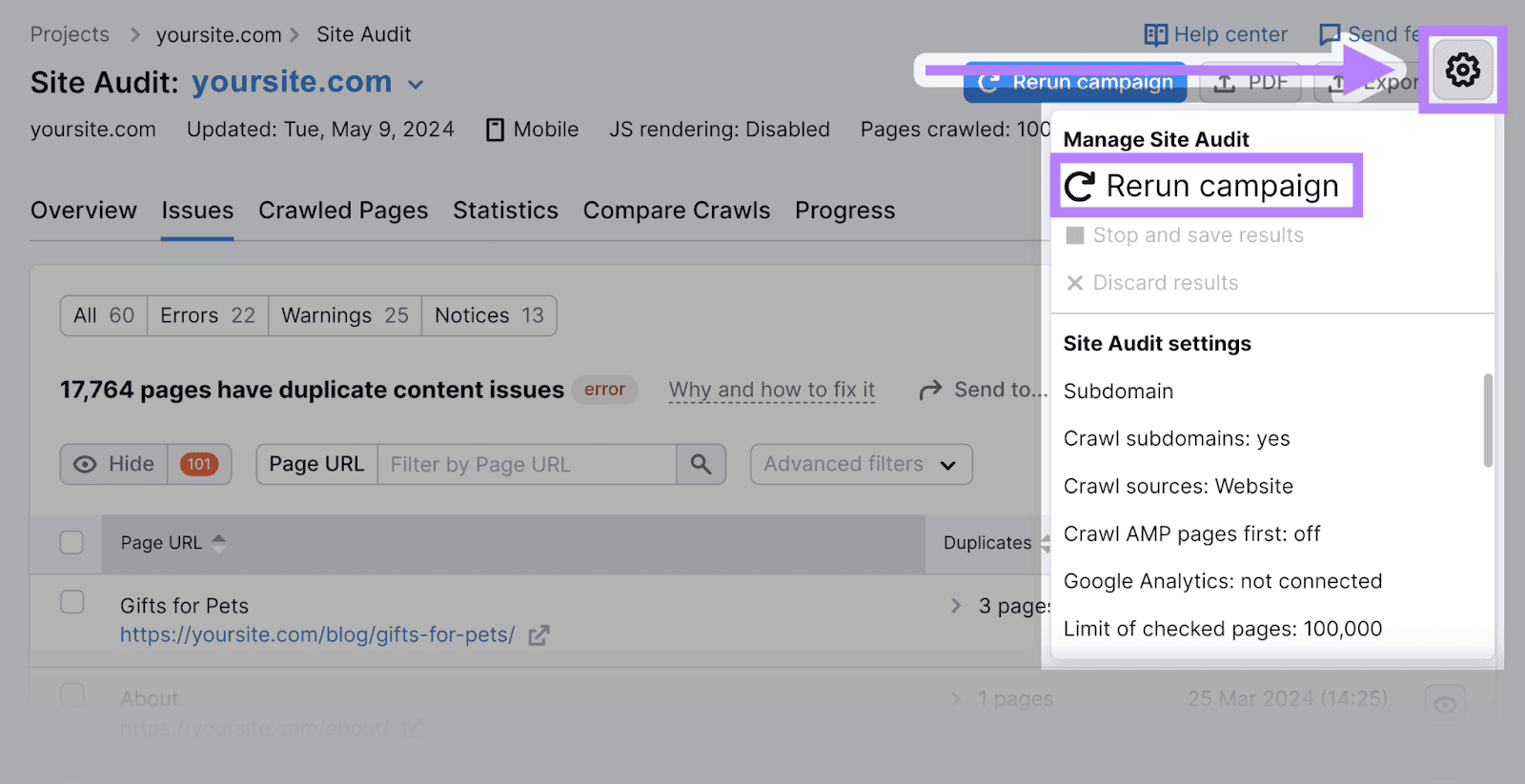
Then, verify that the canonical errors have disappeared through the use of the search bar as soon as extra.
Begin Specifying Canonical URLs
Accurately implementing canonical tags is a key a part of technical search engine optimization. And may help enhance your natural search rankings.
So, audit your web site to see if it has any points associated to canonical URLs.
Strive it with Website Audit.
This submit was up to date in 2024. Excerpts from the unique article by James Brockbank could stay.


